CS224n
学习Stanford的CS224n Natural Language Processing with Deep Learning。(课程链接)
[TOC]
Lecture 1. Introduction and word vector
introduction
- basic和key mothods:RNN attention transformers
- 理解对人类自然语言理解中问题
- 用PyTorch构建模型,解决word meaning,dependency parsing,machine translation,QA等问题
NLP levels
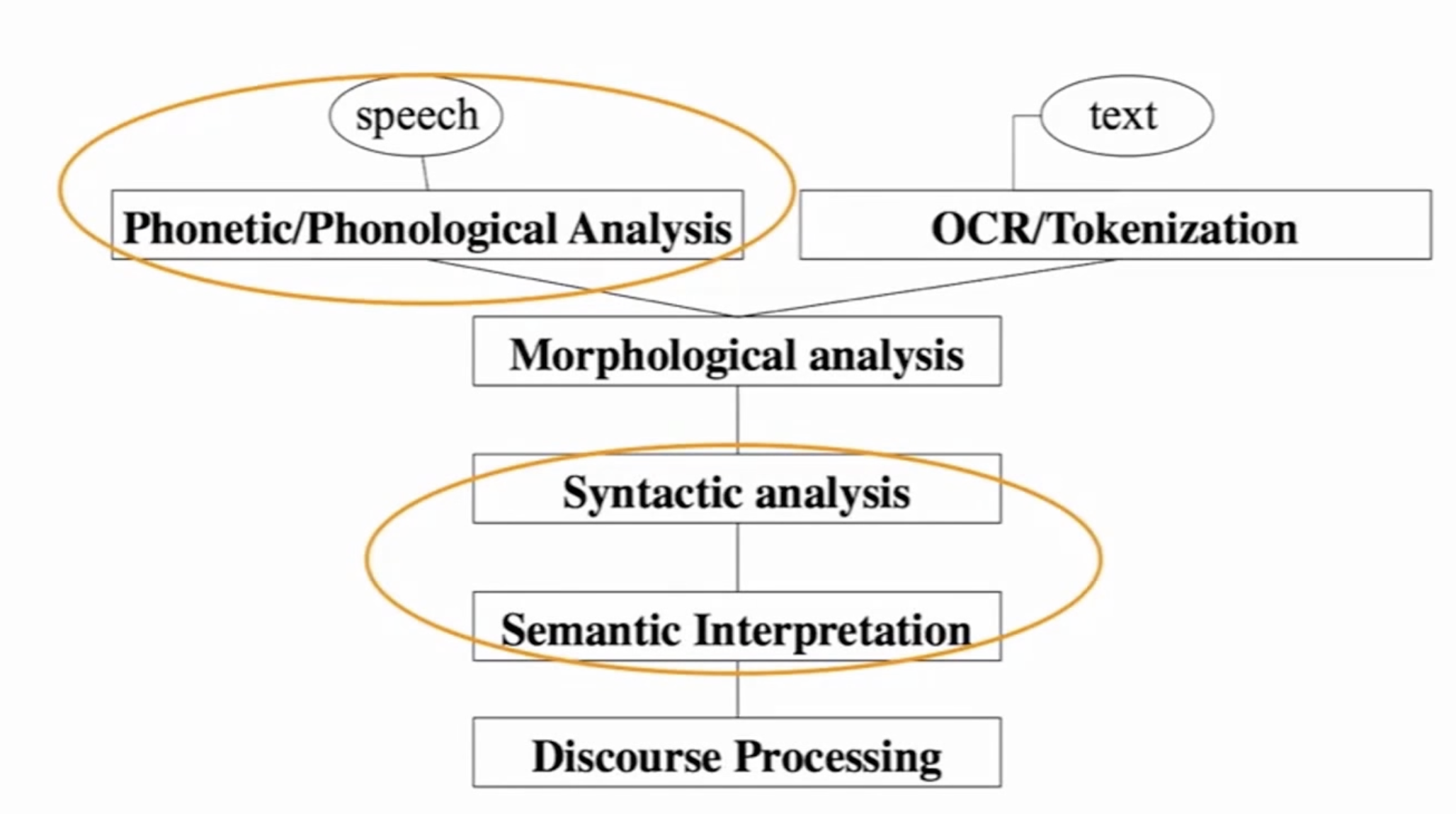
输入speech text->单词分析->句法分析->语义理解->上下文处理
human language
language is discrete/symbolic/categorical signaling system
- rocket=🚀 violin=🎻
- love loooove
人类语言是一套符号系统,深度学习领域将大脑视为有连续的激活模式。
deep learning
- machine learning:由人类审视一个特定的问题,找出问题中的关键要素,设计useful features/signals,使用这些features解决问题,机器做数值优化。大部分工作是人类的数据分析。
- 手动设计的特征过于具体,长时间设计和调整
- deep learning:表征学习的一个分支,输入原始的真实世界信号,机器自己学习特征,可以得到多层的learned representations。
- deep learning的特征适应性强,训练快,可以灵活通用地学习
- 海量数据+算力提升
Word Vector (represent the meaning of a word)
meaning
- 用一个词、词组表示的概念
- 一个人想用语言、符号表示的想法
- 表达在文学、艺术作品等方面的思想
理解meaning的linguistic way:
(指称语义)
how do we have usable meaning in a computer
common NLP solution:WordNet,包含同义词集合和上位词(例如”is a”关系)的列表的词典。
- 同义词和上位词
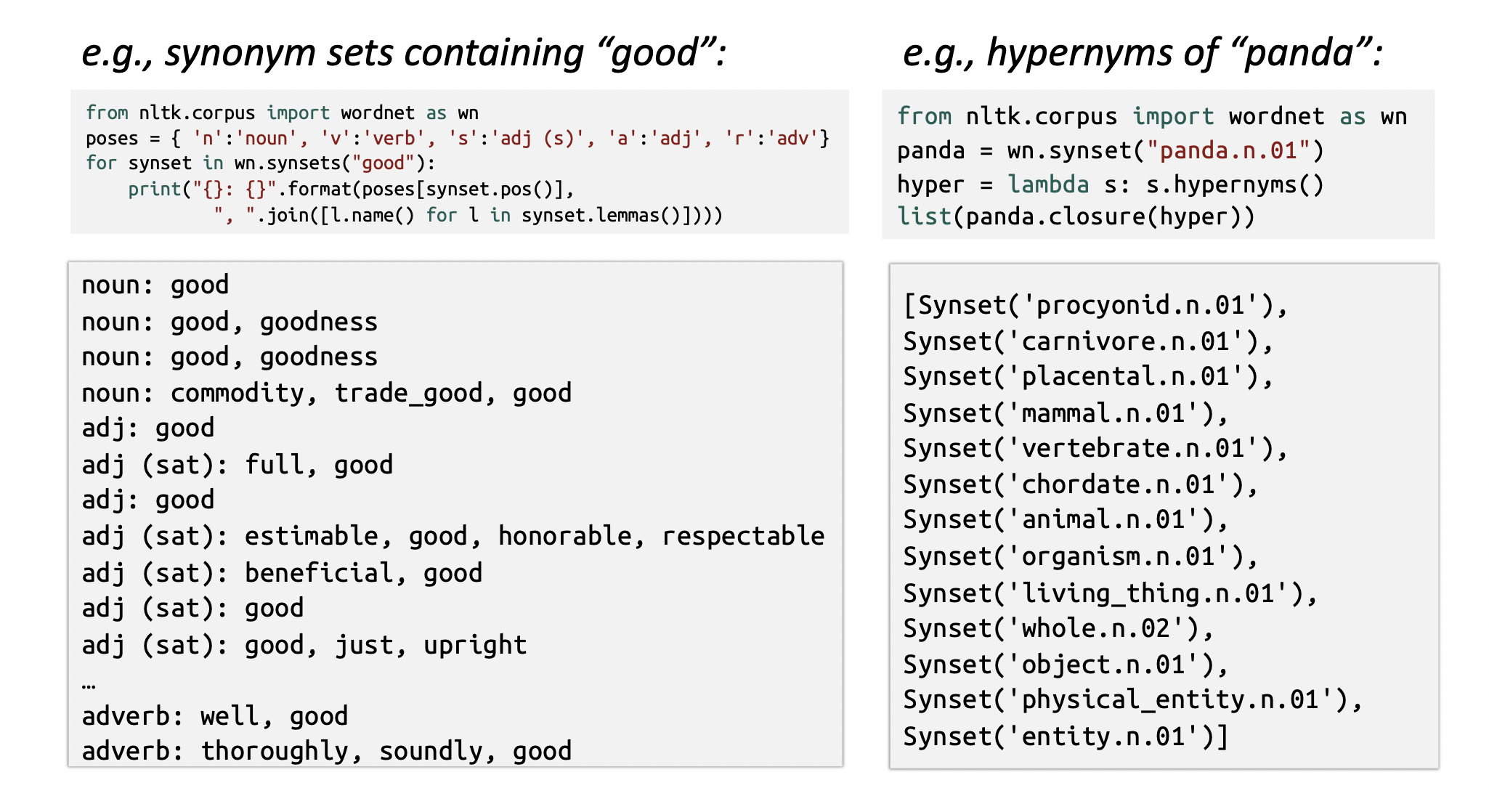
problems with resources like WordNet
- 作为资源使用很好,但忽略了细微差别(missing nuance)
- e.g. proficient 和 good是同义词,但需要结合上下文
- 难以持续更新,缺乏单词的新含义
- 比较主观subjective
- 需要人力物力创建和调整词库
- 没有单词相似度的概念
representing words as discrete symbols
在传统NLP中,word被视为离散符号,被表示为one-hot vec。
- problems:
- 所有的vec都正交
- one-hot vec没有相似度的概念
- 向量维度太大
- solution:
- 使用类似wordnet的list来表示相似度,但有不完整性
- 学习使用real-value vec本身来编码计算相似度
Representing words by their context
- 分布式语义(distributional semantics):word的语义由经常出现在其附近的单词给出。
- 当一个单词w出现在一段文本中时,在一个固定大小的窗口内co-occur的单词就是w的上下文词,使用w的contexts来构建w的表示
word vector/word embedding/word representation
为每个单词构建dense vec,使其与context中出现的单词的dense vec相似。
- word2vec
- glove
- sanjiv aurora’s paper
word2vec(Mikolov et al. 2013)
一个学习word vec的框架:
- 有一个大的语料库corpus
- 词汇表中的每个单词用一个vec表示
- 对text中的每个位置t,有一个中心词$c$和一些上下文(context/outside)词$o$
- 用c和o词向量的相似性来计算给定$c$时$o$的概率$P(o|c)$
- 不断调整词向量,最大化这个概率$P(o|c)$
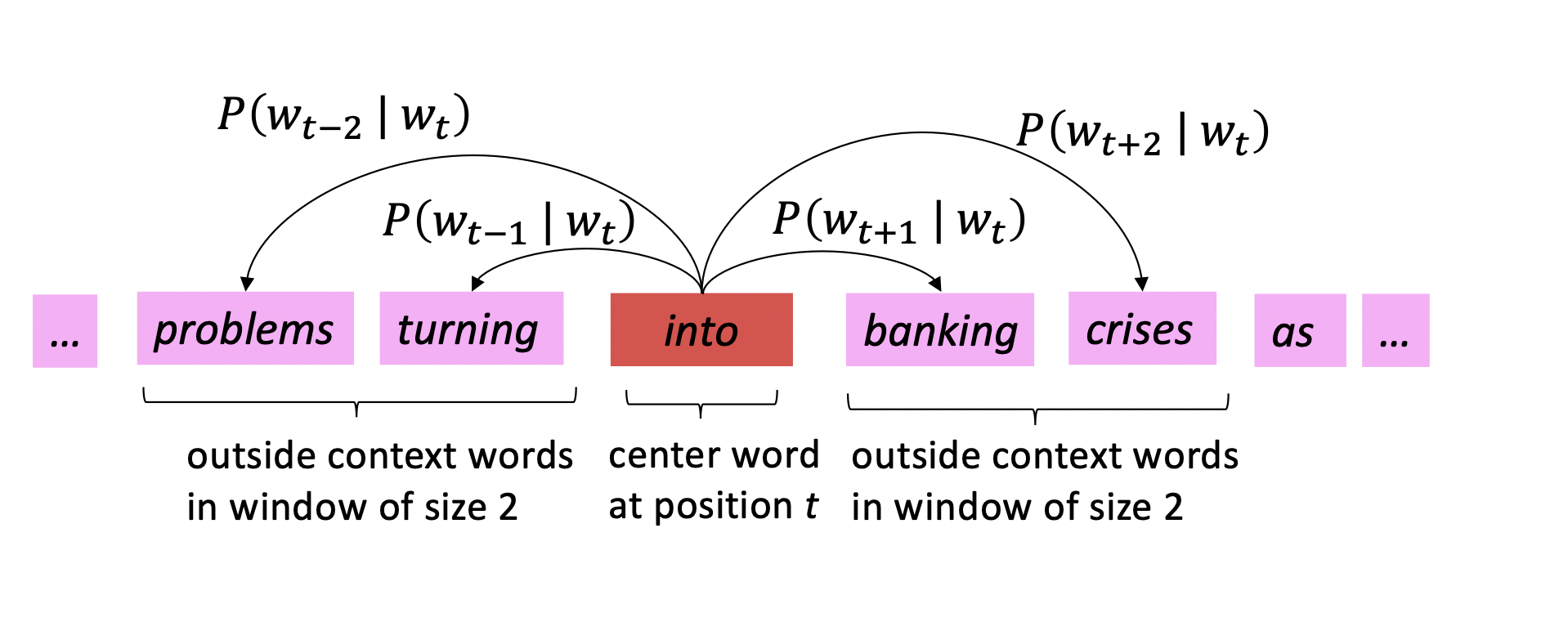

word2vec objective func
对每个位置$t=1,\cdots,T$,在一个大小为$m$的固定窗口内预测context words,给定中心词$w_j$,有
$Likelihood=L(\theta)=\Pi^T_{t=1}\Pi_{-m\le j\le m,j\neq 0}P(w_{t+j}|w_t;\theta)$
目标函数为:
$J(\theta)=-\frac{1}{T}\Sigma_{t=1}^T\Sigma_{-m\le j\le m,j\neq 0}\ log\ P(w_{t+j}|w_t;\theta)$
经典的$\Pi$通过log变成$\Sigma$,最小化目标函数->最大化似然函数
- 如何计算 $P(w_{t+j}|w_t;\theta)$
- $v_w$:w为中心词的vec
- $u_W$:w是上下文词的vec
- 则$P(o|c)=\frac{exp(u_o^Tv_c)}{\Sigma_{w\in V}exp(u_w^Tv_c)}$,向量点积越大即相似度越高
此处使用Softmax:$\mathbb{R}^n->(0,1)^n$将点积得到的任意值$x_i$映射到概率分布$p_i$
梯度下降
在负梯度上take small step
Gradient
Update equation
$\theta^{new} = \theta^{old} - \alpha \bigtriangledown_\theta J(\theta)$1
2
3while True:
theta_grad = evaluate_gradient(J, corpus, theta)
theta = theta - alpha * theta_grade
Lecture 2. Word Vectors 2 and Word Window Classification
stochastic gradient descent(SGD)
- 问题:$J(\theta)$是语料库中所有window的函数,梯度计算开销很大
- 方案:SGD,随机采样windows,在每个window或batch后update
1 | while True: |
more details
两个向量:更好优化,center vec和context vec最终会是相似的
两类模型:
- Skip-Grams: 给定中心词预测上下文
- Continuous Bag of Words: 给定(bag of)上下文词,预测中心词
其他训练策略:
- negative sampling
- negative sampling for naive softmax
word2vec 比较crude,很大程度上忽略了词的具体位置
skip-gram model with negative sampling(HW2)
$P(o|c)=\frac{exp(u_o^Tv_c)}{\Sigma_{w\in V}exp(u_w^Tv_c)}$中分母的计算开销过大
Main idea:用true pair(中心词与其上下文窗口中的词)与几个noise pair(中心词与随机词)训练二元逻辑回归
maximize目标函数:$J(\theta)=\frac{1}{T}\Sigma^T_{t=1}J_t(\theta)$
$J_t(\theta)=log\ \sigma(u_o^Tv_c)+\Sigma^k_{i=1}\mathbb{E}_{j\sim P(w)}[log\ \sigma(-u^T_jv_c)]$
$\sigma(x)=\frac{1}{1+e^{-x}}$
maximize前半部分真实上下文词的概率,minimize后半部分负采样随机词的概率
负采样方案:$P(w)=U(w)^{3/4}/Z$,$U(w)$是unigram分布,用幂提升罕见词的采样概率,$Z$为归一化。
why not capture co-ocurrence counts directly?
构建co-occurence matrix $X$的两种方法:
- 窗口windows:与w2v类似,使用中心词附近的window,捕获句法和语义信息
- 全文full document:窗口大小设为文章长度,常用于信息检索方法中,如Latent Semantic Analysis
问题:
- 词表变大则向量维度也要增大,但向量很稀疏
- 分类模型也会遭遇稀疏的问题,鲁棒性差
需要使用low-dim的dense matrix。
Classic Method Dimensionality Reduction on X(HW1)
用SVD分解$X$为$U\Sigma V^T$,$U$和$V$对应行和列的正交基。
为了减少尺度,可以保留$\Sigma$对角阵中的topK最大值,并保留$U,V$对应的行列。
- 直接对原始的count做SVD效果很差,需要对数字进行调整:
- 取log
- 取$min(X,\delta)$
- 忽略虚词的count
- 使用斜坡ramped window,对更近的词计更大的count
- 用Pearson相关系数(Pearson Correlation Coefficient)代替count,然后将负值置零
Towards GloVe:Count based vs direct prediction
- count based:基于co-occurence
- LSA、HAL、COALS、Hellingger-PCA
- 训练快;有效使用统计数据
- 主要用于捕获词相似性;过分重视count大的数据
- direct prediction:定义概率分布,根据概率预测词
- Skip-gram/CBOW、NNLM、HLBL、RNN
- 规模跟corpus大小有关;没有有效利用统计数据(采样和窗口)
- 提高了在其他任务上的表现;可以捕获相似度之外更复杂的信息
Encoding meaning in vector differences
结合两种方法,在神经网络中引入count矩阵
核心思想:co-orrurrence概率之比可以编码meaning components
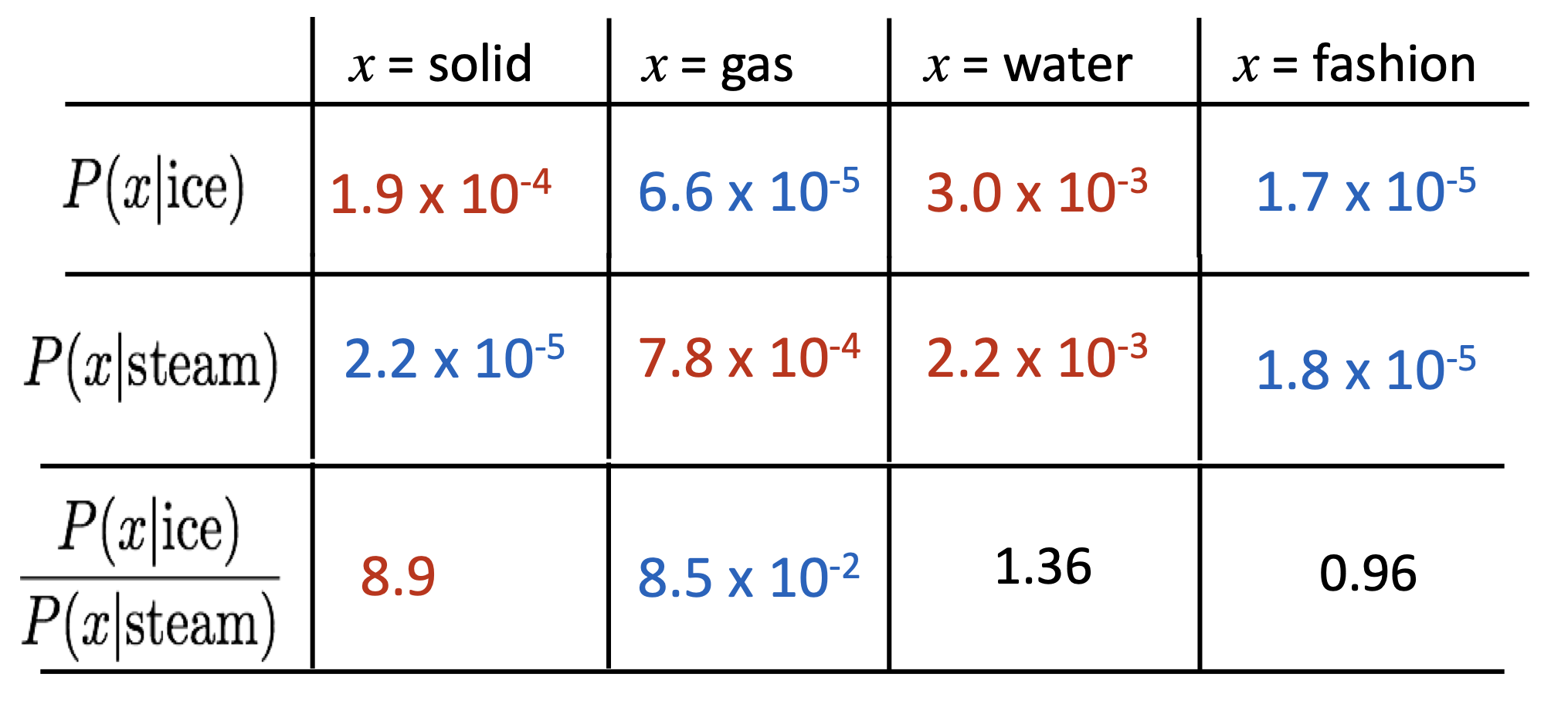
单一的概率并非重点,概率的比值更能反映(linear) meanning component。
关键:$\frac{P(x|a)}{P(x|b)}$如何在词向量空间中捕获?
- 用向量的点积表示co-occurence 概率的对数
- $w_i\cdot w_j = log P(i|j)$
- $w_x\cdot (w_a - w_b)\frac{P(x|a)}{P(x|b)}$
- $J=\Sigma^V_{i,j=1}f(X_{ij})(w_i^T\tilde w_j+b_i+\tilde b_j-log X_{ij})^2$
$f$限制了常见词的count
how to evaluate word vectors
- Intrinsic
- 在特定和中间子任务上评估
- 评估运算很快
- 有助于理解整个系统
- 在用于实际任务前不清楚是否有用
- Extrinsic
- 在实际任务上评估
- 通常需要更长时间(任务更大)
- 不清楚系统整个系统的问题所在
word sense and word sense ambiguity
- 多义的word 和 一一对应的word vec相悖
imporving word representations via global context and multiple word prototypes(Huang et al. 2012)
对常用词的所有context聚类,从而得到一些表示不同含义的簇。
划分并不明确且存在重叠。
Linear Algebraic Structure of Word Senses, with Applications to Polysemy
- 单词的不同含义以加权的线性形式叠加:
$v_w=\Sigma\alpha_iv_{w_i}$
$\alpha_i=\frac{f_i}{\Sigma f_j}$ - 实际上,用稀疏编码Sparse coding的思想,不同维度表示了不同的含义,所以weighted-avg对不同含义的维度损失很小。
Lecture 3. Backprop and Neural Networks
matrix calculus
gradient
- 单输出多输入的函数$f(\mathbf{x})=f(x_1,\dots,x_n)$
- 梯度gradient是关于每个输入的偏导数partial derivatives的向量$\frac{\partial f}{\partial x}=[\frac{\partial f}{\partial x_1},\dots,\frac{\partial f}{\partial x_n}]$
Jacobian Matirx: Generalization of the Gradient
- 多输出多输入的函数$\mathbf{f(x)}=[f_1(x_1,\dots,x_n),\dots,f_m(x_1,\dots,x_n)]$
- Jacobian mat是$m\times n$的矩阵:
$\mathbf{\frac{\partial f}{\partial x}}=
\begin{bmatrix}
\frac{\partial f_1}{\partial x_1} & \dots & \frac{\partial f_1}{\partial x_n} \\
\vdots & \ddots & \vdots \\
\frac{\partial f_m}{\partial x_1} & \dots & \frac{\partial f_m}{\partial x_n} \\
\end{bmatrix}$
chain rule
多变量的链式法则:乘Jacobian mat
example:NER
- 找出文本中的实体并分类

- Idea:通过上下文窗口来对每个词分类,对每个类训练logistic分类器
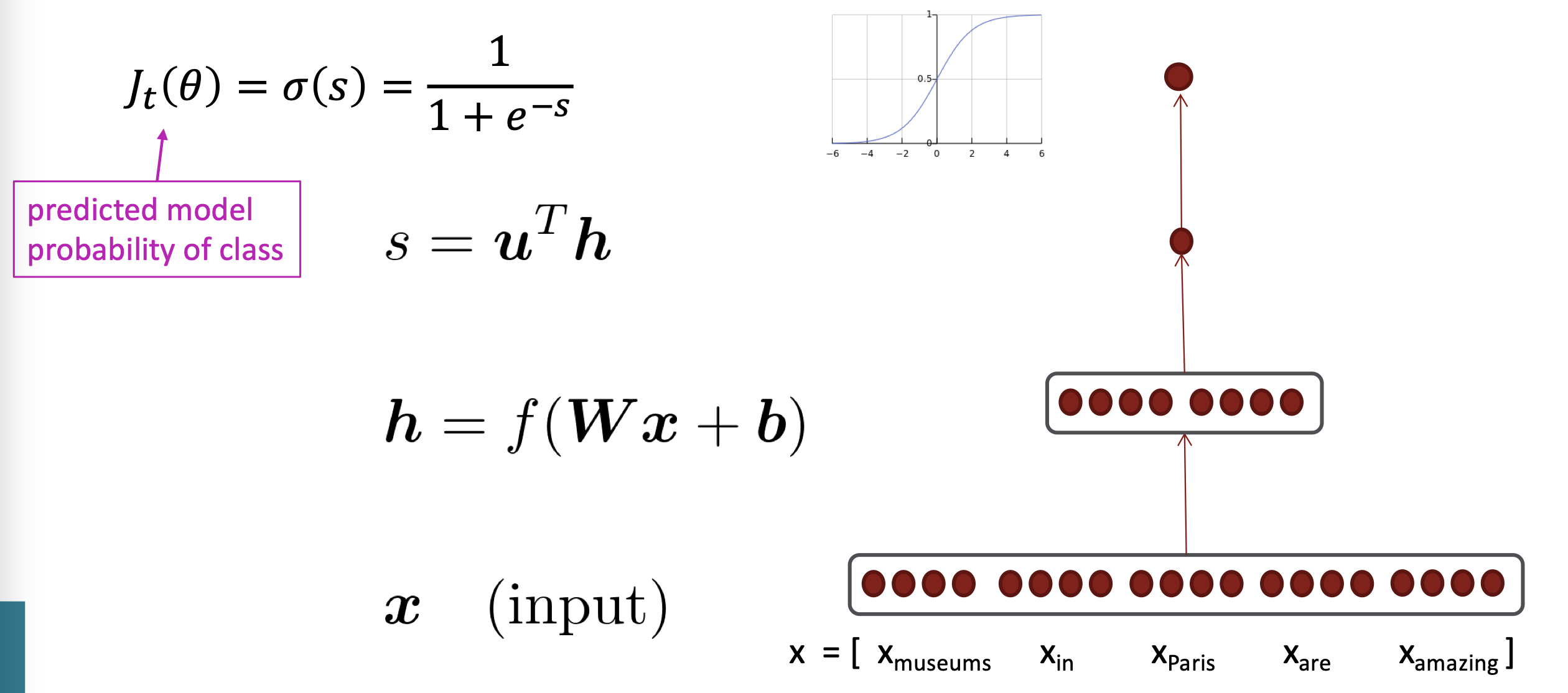
计算梯度
- 计算$\frac{\partial s}{\partial \mathbf{b}}$
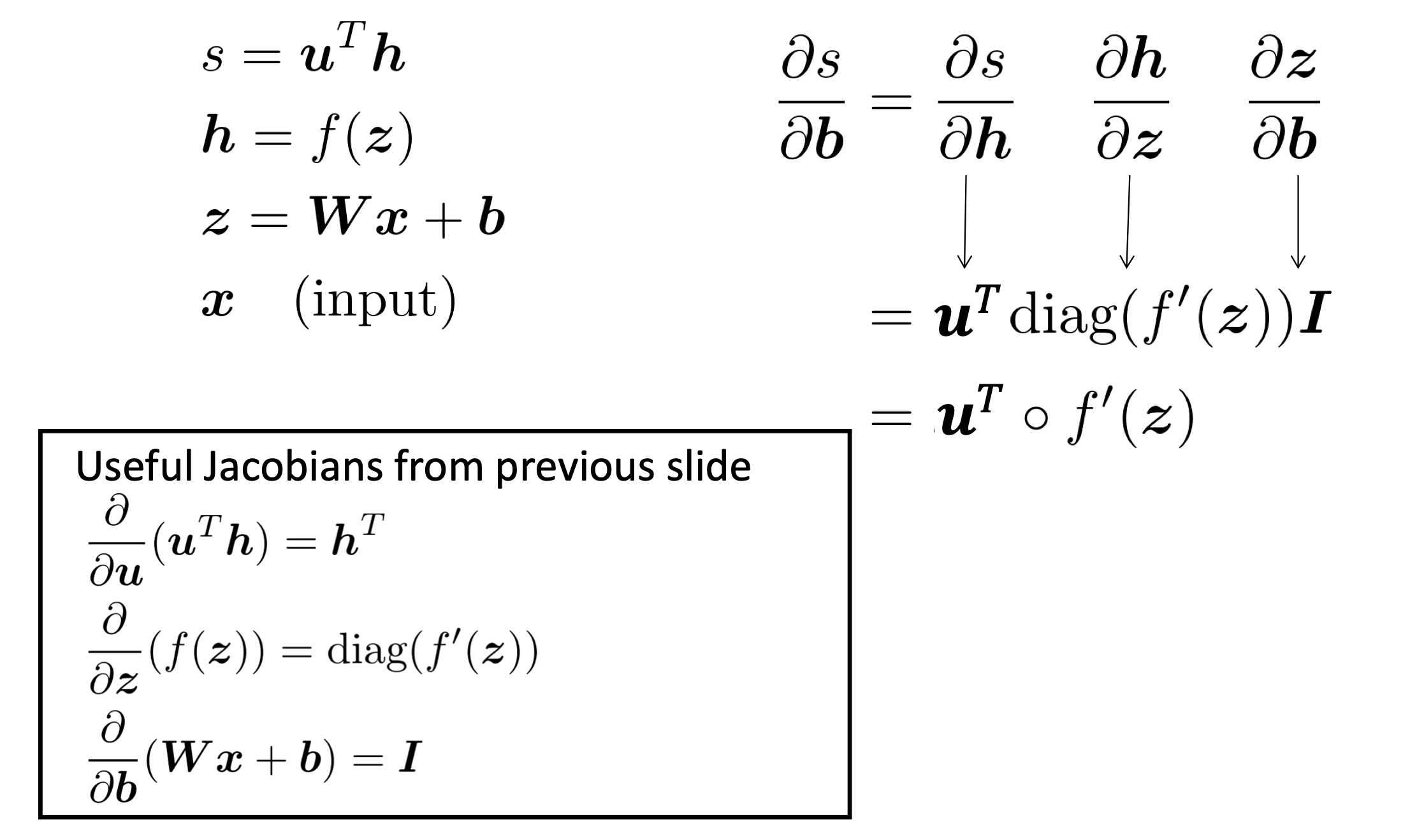
- 计算$\frac{\partial s}{\partial \mathbf{W}}$
与上述过程相似,其中前两项是一致的,无需重复计算
$\frac{\partial s}{\partial \mathbf{W}}=\delta\frac{\partial z}{\partial \mathbf{W}}$
$\delta=\frac{\partial s}{\partial \mathbf{h}}\frac{\partial \mathbf{h}}{\partial z}=\mathbf{u}^T\circ f’(z)$是local error signal
derivative with respect to Matrix: output shape
- 输出大小为1,输入大小为$n\times m$.
- 从数学角度,输出应该为$1\times nm$
- 但为了方便更新参数,其shape应为$n\times m$
$\frac{\partial s}{\partial \mathbf{W}}=\delta^Tx^T$,transpose可以解决shape的问题
Lecture 4. Dependency Parsing
Dependency Parsing
constituency Parsing
constituency = phrase structure grammer = context-free grammers(CFGs)
- starting unit:word
- words 组合成短语
短语可以递归地组合成更长的短语
Det Determiner限定词
- NP Noun Phrase名词短语
- VP Verb Phrase动词短语
- P Preposition 介词
- PP Prepositional Phrase介词短语
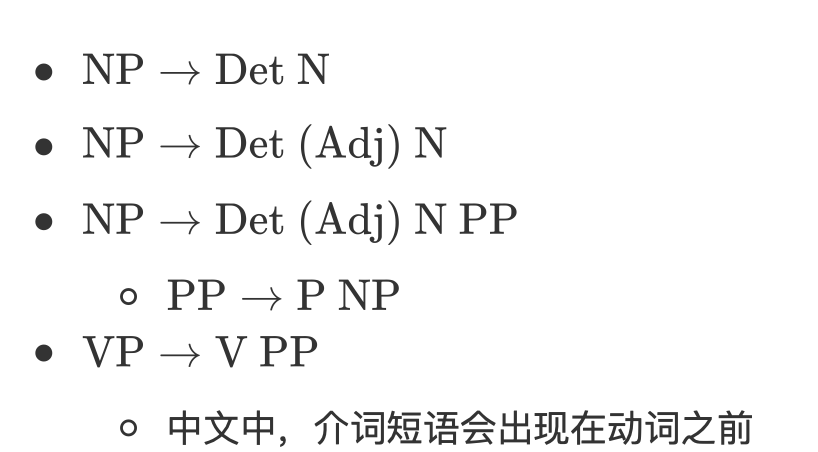
dependency structure
用单词间的依赖/修饰关系表示句子的结构
why do we need sentense structure
- 自然语言中将单词组合成更大的短语、句子来表达复杂的含义和思想
- 人类在理解自然语言是需要弄清楚单词间的相关性
- 自然语言模型需要同样的、理解句子结构的能力
some ambiguity
PP attachment ambiguity 介词短语歧义
San Jose cops kill man with knife
- San Jose cops kill man with knife
- knife是man的modifier
- San Jose cops kill man with knife
- knife是kill的modifier
- San Jose cops kill man with knife
关键是如何分析依存关系
- 对复杂的句子结构,有指数级的依存关系parsing tree
- Catalan number $C_n=(2n)!/[(n+1)!n!]$
出现在树形结构的环境中,如n+2多边形的三角剖分可能数
coordination scope ambiguity 协调范围模糊
- Shuttle veteran and longtime NASA executive Fred Gregory appointed to board
- Shuttle veteran and longtime NASA executive Fred Gregory appointed to board
- shuttle veteran 和 longtime NASA executive 都是指Fred
- Shuttle veteran and longtime NASA executive Fred Gregory appointed to board
- 仅longtime NASA executive 是指Fred
- Shuttle veteran and longtime NASA executive Fred Gregory appointed to board
adj adv modifier ambiguity
- Students get first hand job experience
- Students get first hand job experience
- first hand 修饰 job
- Students get first hand job experience
- first hand 修饰 experience
- Students get first hand job experience
VP attachment ambiguity
- Multilated body washed up on Rio beach to be used for Olympics beach volleyball
- Multilated body washed up on Rio beach to be used for Olympics beach volleyball
- to be used 修饰 body
- Multilated body washed up on Rio beach to be used for Olympics beach volleyball
- to be used 修饰 beach
- Multilated body washed up on Rio beach to be used for Olympics beach volleyball
dependency grammar and dependency structure
dependency syntax中单词间的关系通常是二元不对称的依赖关系(箭头 )
- 箭头连接head和dependency
- head->dependency
- 依赖关系形成单头无环的图
- 通常额外引入一个ROOT节点,使所有单词有head
universal dependency treebanks
统一、并行、通用的依赖关系描述
- 人工编写语法规则,训练得到parser
- 规则愈发复杂,不能重用之前的工作
treebank
- 起初构建treebank比语法规则要慢且用处有限
- 可重用
- 在treebank基础上建立parser、tagger等
- 语言学的
- 覆盖面广泛
- 利用了统计信息
- 可以评估NLP系统
dependency conditioning preference
依赖解析的信息:
- Bilexical affinities两个单词间的密切关系
- Dependency distance:大多数依赖都是和相邻词的
- intervening material:依赖关系很少跨越中间动词or标点符号
- valency of head:不同类型head的依赖关系位置相对固定
Dependency Parsing
- 为每个单词选择其dependency来解析句子
- 只有一个单词是依赖于root的
- 不能成环(只能成tree)
- 箭头可以交叉,不交叉的称为non-projective

projectivity
- 单词按线性顺序排列时,没有交叉的dependency。
- CFG树的依赖关系必须是projective的
- non-projective结构解释移位的word
介词搁浅
methods
- Dynamic programming
- Eisner提出的复杂度为$O(n^3)$的clever algo,通过在末尾而非中间生成head
- Graph algo
- 对句子建立最小生成树(Minimun Spanning Tree)
- constraint satisfaction
- 去掉不满足硬约束的edge
- transition-based parsing or deterministic dependency parsing
- 基于ml classifier的贪心选择
- 比较复杂,具体详见本课程Lecture4
Lecture 5. Recurrent Neural Networks and Language Models
how do we gain from a neural dependency parser
indicator feature 的问题:
- 这样的特征向量很稀疏
- 特征不完整
- 特征的计算开销很大
distributed representation
- 将每个单词表示为dense vector
- part-of-sppeech tags和dependency labels也被表示为同样维度的dense vector
deep learning and non-linear classifier
- 传统 ML classifer只有linear boundary
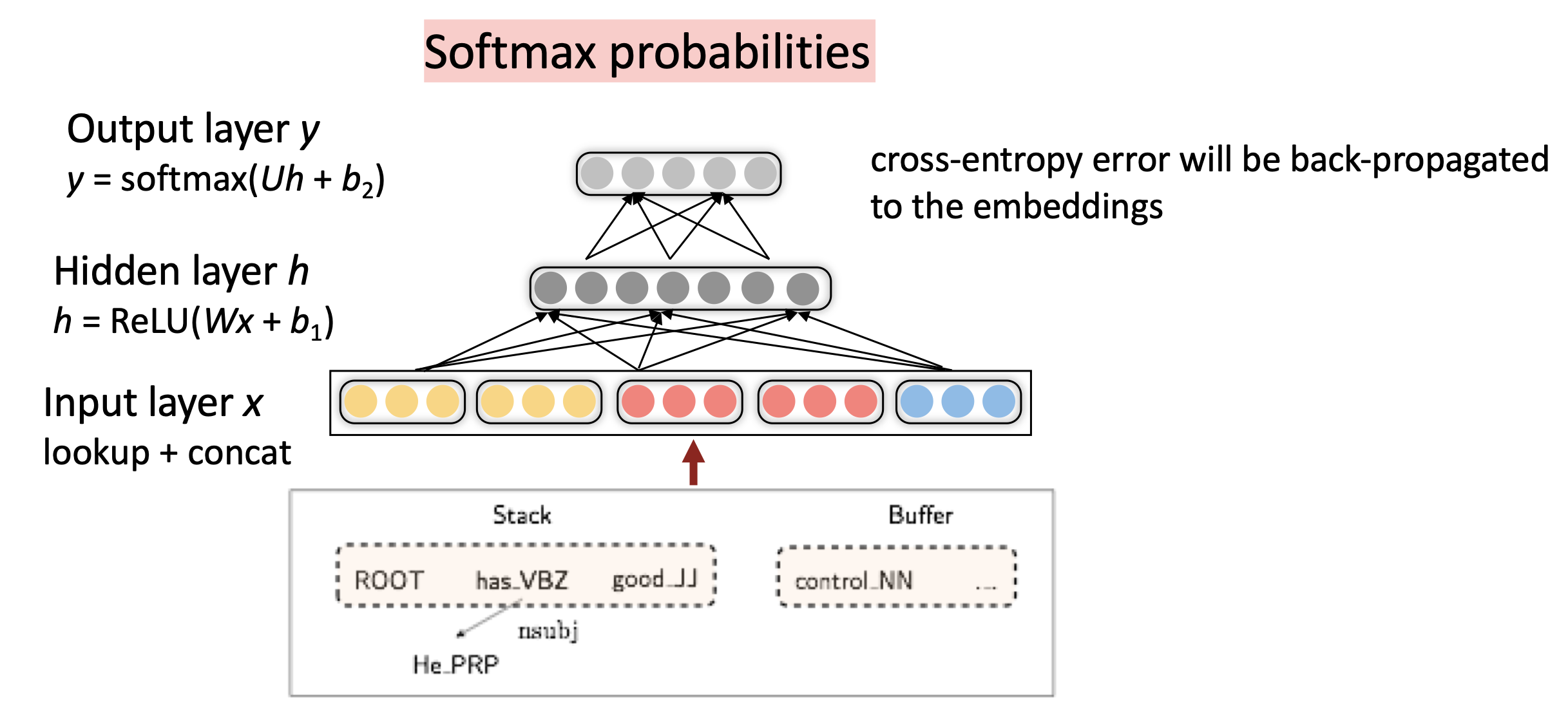
graph-based dependency parsers
- 对每个可能的dependency计算score
- 需要理解单词的contextual representation
more things about NN
regularization
- 完整的loss func包含对所有参数$\theta$的正则化
- L2 regularization $\lambda\Sigma_k \theta_k^2$
- 正则化可以防止大量特征/深层模型出现过拟合
- 为模型提供了更强的泛化能力(过拟合实际上不是问题,需要泛化能力)
dropout
- 在训练时随机将神经元输出特征的一部分置零(从而不更新该部分权重)
- 避免特征co-adaptation:不会出现某特征仅在其他特征出现时才有用的情况
- 在单层中,可以看做naive bayes(所有权重被独立设置)和logistic regression(权重在所有上下文中设置)的折中
- 可以看做一种model bagging(ensemble model),或是一种特征独立的强正则化
non-linearities
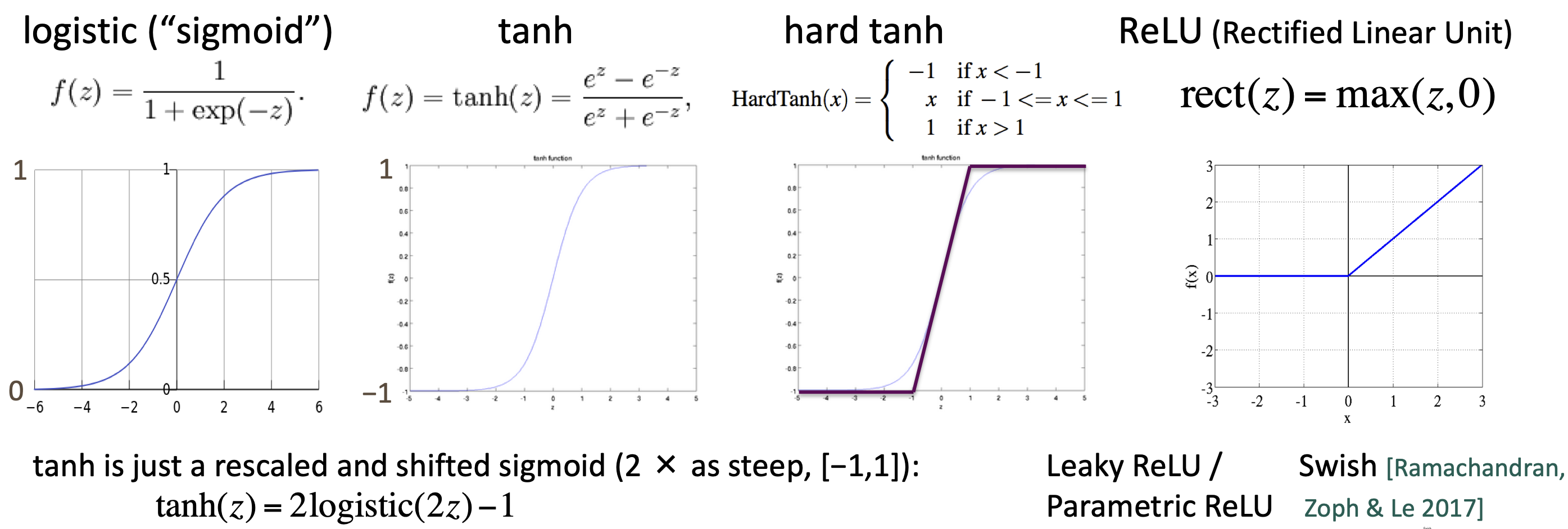
- old:指数级计算
- logistic(sigmoid):0~1
- tanh:1~-1,实际上是重新缩放和移动的sigmoid
- $tanh(z)=2sigmoid(2z)-1$
- new
- hard tanh
- ReLU
- 神经元要么dead要么就在传递信息
- 有很好的梯度backflow,训练很快
- varient
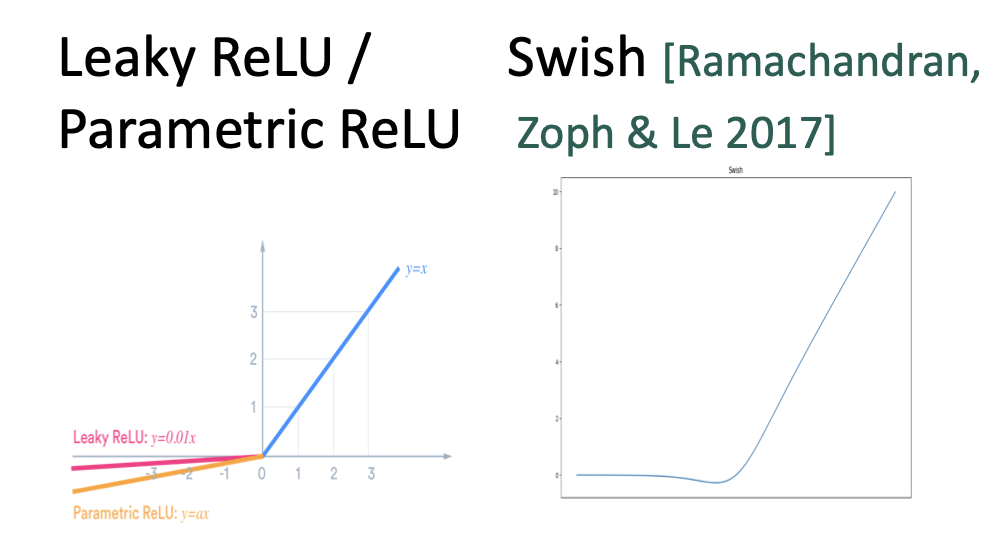
prameter initialization
- 将权重初始化为小随机值,避免对称性影响学习
- Uniform(-r,r)
- Xavier初始化中,方差和前后层的尺寸有关
- $Var(W_i)=\frac{2}{n_{in}+n_{out}}$
optimizers
- 简单的SGD很有效
- 其他优化器
- Adagrad
- RMSprop
- Adam(安全有效)
- SparseAdam
Learning Rate
- lr太大模型会不收敛,太小模型效果会变差
- 在训练时通常需要动态调整lr
- by hand:k个epoch后减半
- by formula:$lr=lr_0e_{-kt}$, for epoch t
- 循环lr
language model and RNN
language modeling
- 语言模型的任务是预测下一位置的单词
- 给定单词序列$x^{(1)},\dots,x^{(t)}$,计算下一单词$x^{(t+1)}$的概率分布$P(x^{(t+1)}|x^{(t)},\dots,x^{(1 )})$
- 语言模型也可以看做将概率分配给一段text
- $P(x^{(1)},\dots,x^{(t)})=\Pi^T_{t=1}P(x^{(t)}|x^{(t-1 )},\dots,x^{(1 )})$
n-gram language model
- n-gram:由n个单词组成的块
- 统计不同n-gram出现的频率来预测下一个单词
Markov假设:
- $x^{(t+1)}$只取决于之前的n-1个单词
$\begin{aligned} P(x^{(t+1)}|x^{(t)},\dots,x^{(1 )})&=P(x^{(t+1)}|x^{(t)},\dots,x^{(t-n+2)})\\
&= \frac{P(x^{(t+1)},\dots,x^{(t-n+2)})}{P(x^{(t)},\dots,x^{(t-n+2)})} \\
&= \frac{\text{prob of n-gram}}{\text{prob of (n-1)-gram}}\end{aligned}$
- $x^{(t+1)}$只取决于之前的n-1个单词
使用count的统计近似计算以上概率
sparsity problem with n-gram
- 问题:(n-1)-gram + w 的形式不存在,概率为0
- 解决方案:为每个w设置一个$\delta$的小概率(smoothing)
- 问题:(n-1)-gram的形式不存在,概率为0
- 解决方案:回退到(n-2)-gram
- n越大,稀疏问题越严重
generating text with n-gram
- 可以生成语法上正确的text,但语义上不连贯。
- 模拟语言的能力需要更大的n,但与sparsity相悖
neural language model
fixed-window neural language model

优点:
- 不存在sparsity问题
- 不需要使用所有n-gram
问题: - 窗口太小
- 增大窗口需要增大W(增大模型)
- 输入乘以W中不同的权重,对单词的处理不对称
RNN
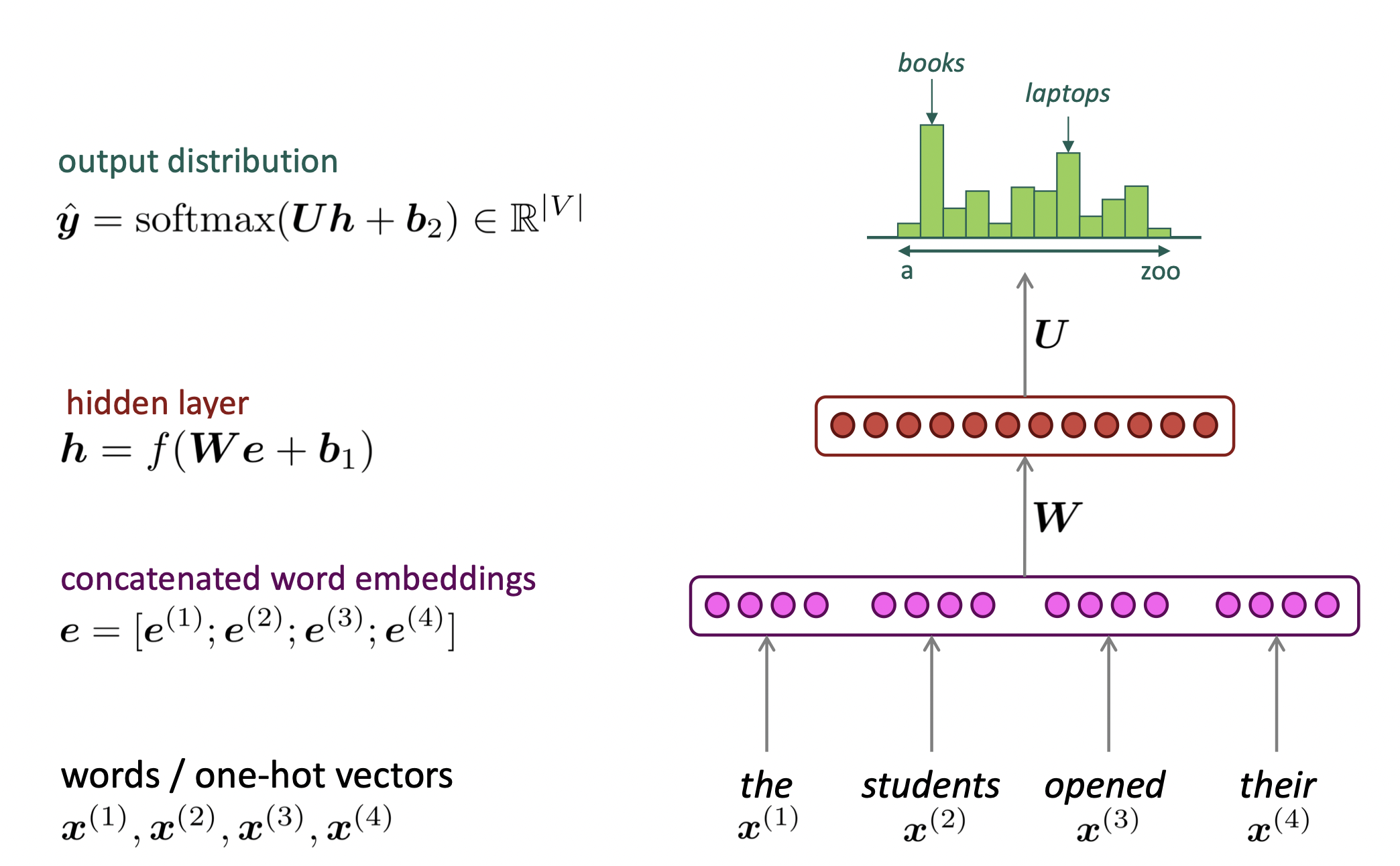
- 核心思想:重复使用同样的Weight
优点: - 可以处理任意长度的输入
- 理论上可以利用序列之前的信息
- 模型大小不会随输入增大而变化
- 在每个timestep上使用对称的处理方式
问题:
- 时序的递归计算慢
- 长程依赖
training RNN LM
计算每一步的输出概率分布
每一步的损失函数:
$J^{(t)}(\theta)=CE(y^{(t)}, \hat{y}^{(t)})=-\Sigma log\ y_w^{(t)}log\ \hat y_w^{(t)}$
总体损失函数
$J(\theta)=\frac{1}{T}\Sigma\ J^{(t)}(\theta)$
- 在整个corpus$x^{(1)},\dots,x^{(T)}$上计算loss和梯度开销很大,通常对一个sentence和document计算并更新weight
backpropagation for RNN
$W_h$是共享参数,梯度计算:
$\frac{\partial J^{(t)}}{\partial W_h}=\Sigma^t_i\frac{\partial J^{(t)}}{\partial W_h}|_{(i)}$
将各时刻的梯度计算后求和。
以上结论可以通过多变量导数的计算来证明。
backpropagation through time
generating text with a RNN LM
不断采样,采样输出是下一步的输入。
- 比n-gram生成的文本更加流畅,但总体上仍不连贯
- 考虑RNN和手工规则的结合
- Beam Search
evaluating LM
- 困惑度perplexity
$\Pi^T_{t=1}(\frac{1}{P_{LM}(x^{(t+1)}|x^{(t)},\dots,x^{(1)})})^{(1/T)}$ - 等于CE-loss的exp
problems with vanishing and exploding gradients
vanishing gradient
- chain rule使反向传播深入后梯度信号越来越小
- proof
- $h^{(t)} = \sigma(W_hh^{(t-1)}+W_xx^{(t)}+b_!)$
- 假设$\sigma(x)=x$
- $\frac{\partial h^{(t)}}{\partial h^{(t-1)}}=diag(\sigma’(W_hh^{(t-1)}+w_x^{(t)}+b_1))W_h=W_h$
- 那么$\frac{\partial J^{(i)}(\theta)}{\partial h^{(j)}}=\frac{\partial J^{(i)}(\theta)}{\partial h^{(i)}}W_h^{(i-j)}$
- 如果$W_h$的特征值均小于1(因为使用了线性的$\sigma$所以为1),则梯度会呈指数衰减;
RNN-LM更善于从顺序上相近的而非语法上相近的单词学习
exploding gradient
$\theta^{new} = \theta^{old} - \alpha \bigtriangledown_\theta J(\theta)$
- 梯度爆炸会让SGD的“步子”过大
- 极端情况下会导致网络中出现inf或NaN
gradient clipping

- 在同样的方向上take a smaller step
how to fix the vanishing gradient problem
- RNN中很难学习若干时间步之前的信息
- 使用具有单独记忆的RNN
LSTM
- 在每一步中,拥有两个hidden vector
- hidden state $h^{(t)}$和cell state $c^{(t)}$
- 二者都是长度为n的向量
- cell state保存长期信息
- LSTM何以从cell读写删信息
- 信息被读/写/删由三个对应的gate控制
- gates也是长度为n的向量
- 每一步上,gate的每个元素可以是open 1/close 0/两者之间的一个概率
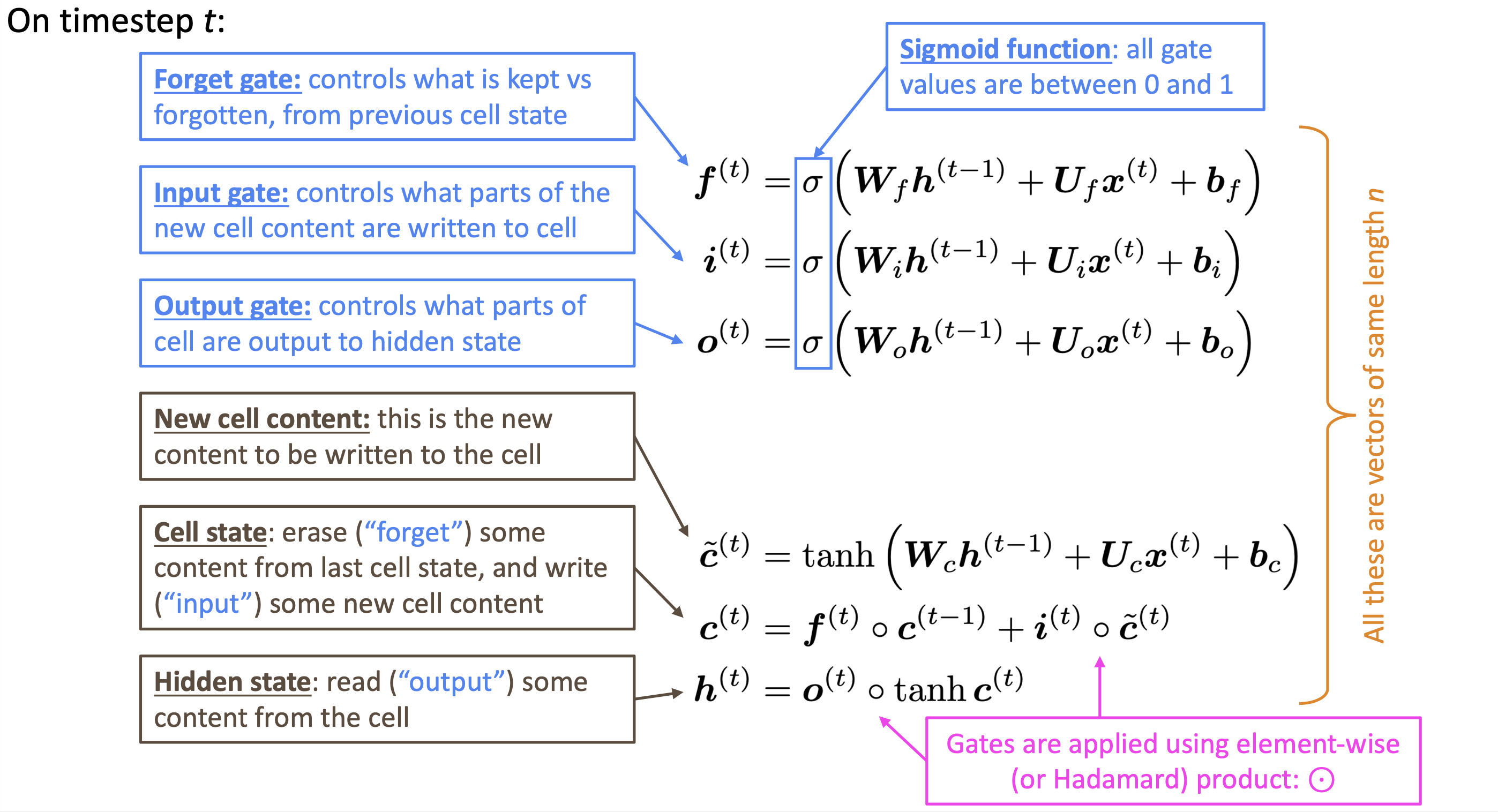
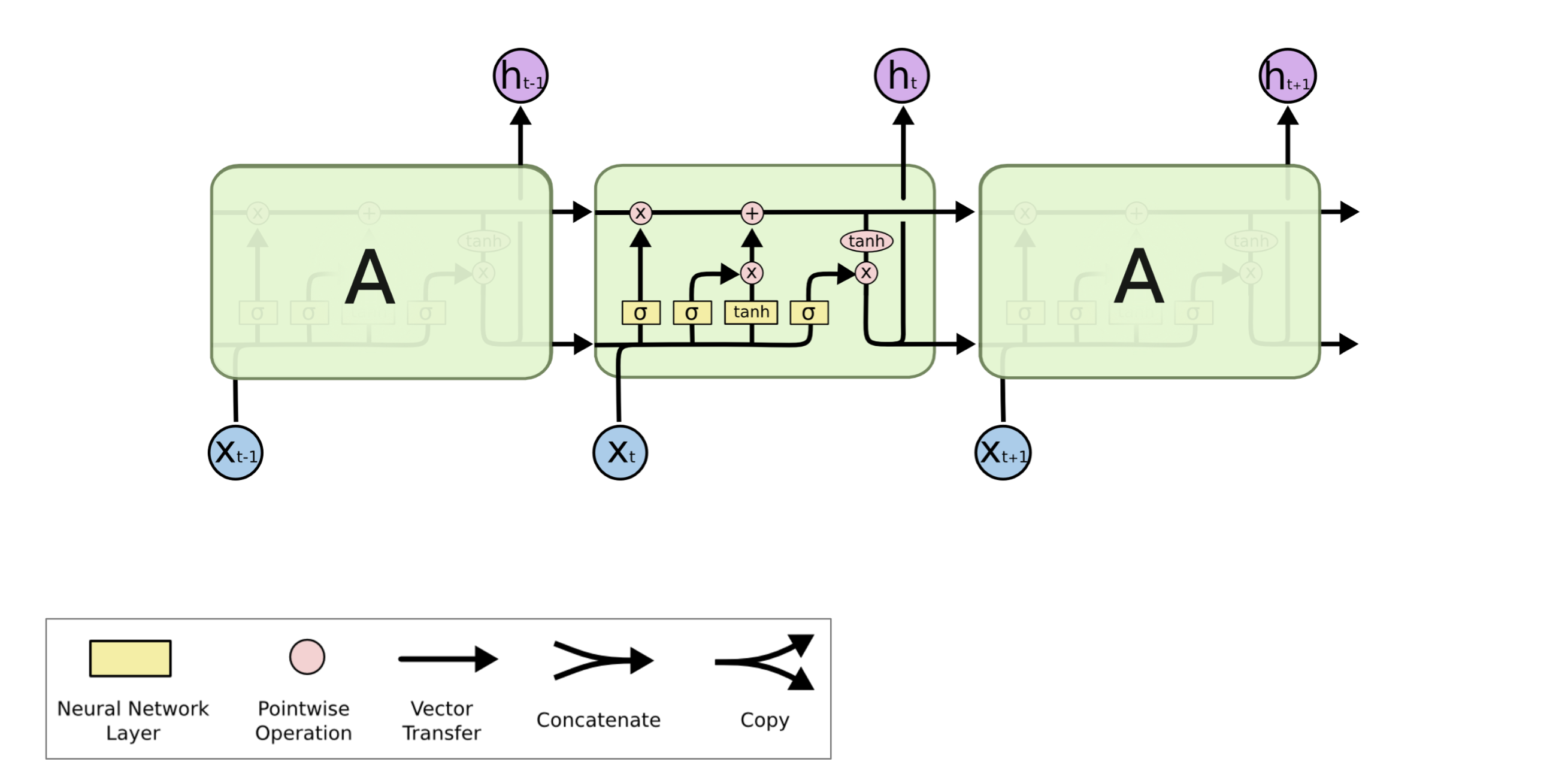
- LSTM相比经典RNN更容易保存时间步上的信息
- 如果forget gate 保存为1,则可以保存所有历史信息
- LSTM的参数也更难学习
- 不保证没有梯度消失和爆炸
is vanishing/exploding gradient just a RNN problem?
- 所有的神经网络结构(尤其是深度解构)都会有
- chain rule和非线性函数会导致反向传播时梯度很小
- 低层次的学习很慢
- RNN中重复乘以统一梯度,更加明显
- solution:添加direct coneection
- residual connection
bidirectional RNN
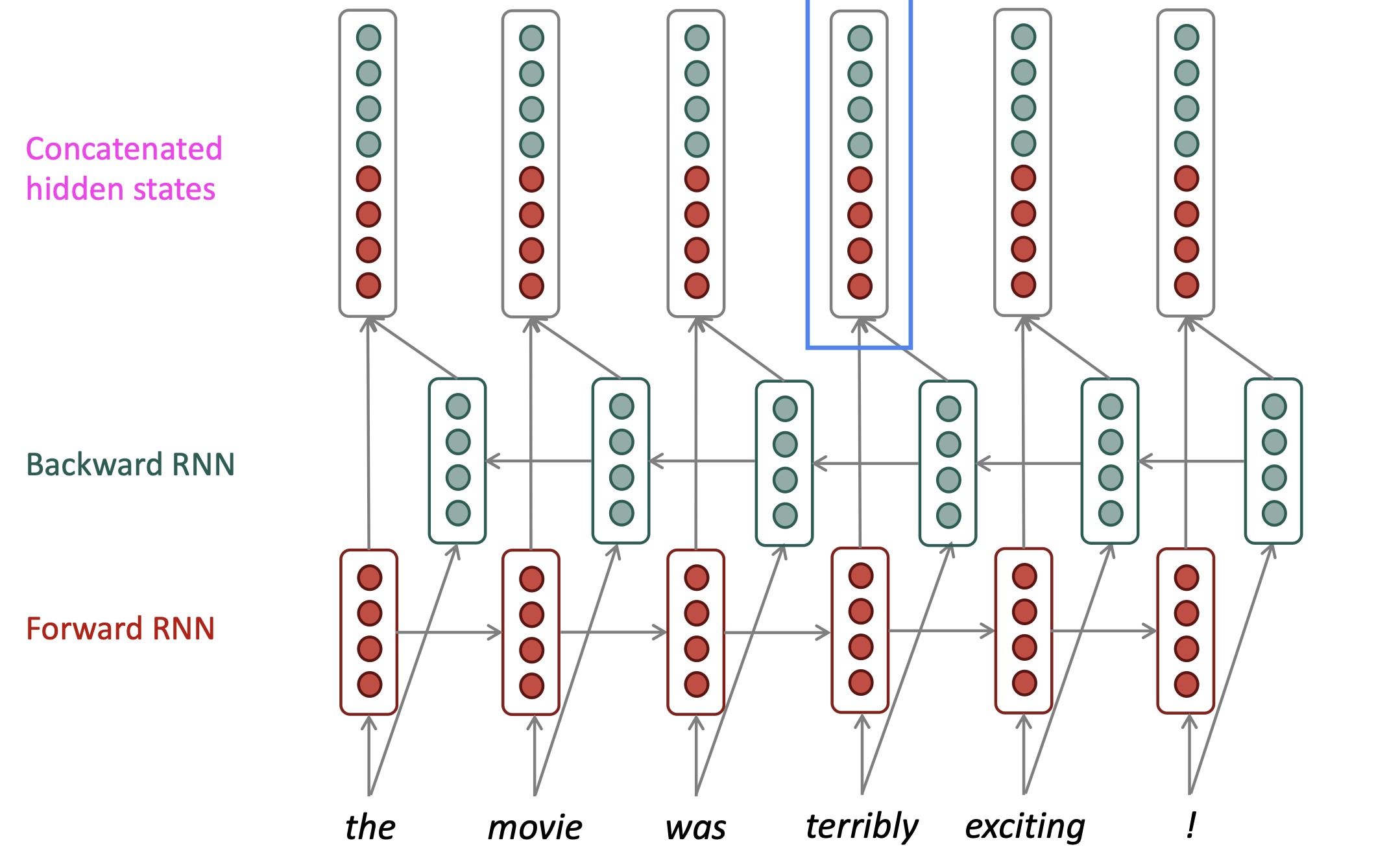
- 包含forward RNN和backward RNN
- 需要有整个输入序列时才能使用(LM中预测下一个word时,相当于只有左边的context,故不能使用双向RNN)
multi-layer RNN
- 堆叠多层RNN,在空间维度上深入(RNN本身是在时序上深入)
- 捕获不同层次的特征
- i层的输入是i-1层的hidden state
- 经验法则:2到4层比较合适
Lecture 7. Machine Translation, Attention, Subword Models
machine translation
statistical MT
- 给定法语sentence x,想要找到最好的英语sentence y
- $argmax_xP(y|x)$
- 用bayes rule可以分解为两个组件:$argmax_xP(x|y)P(y)$
- $P(x|y)$
- 翻译模型,分析单词和短语应该如何翻译
- 从人工翻译的并行数据中学习
- $P(y)$
- 语言模型,模型如何生成合适的语言
- 从单词数据中学习
learning alignment for SMT
- 需要学习$P(x,a|y)$,其中$a$是单词间的对应
- $a$是隐变量,需要用EM算法等来学习
decoding for SMT
- 如何计算argmax,列举所有y并计算概率显然不可行
- 用启发式算法丢弃概率过低的假设
neural MT
sequence-to-sequence model
- encoder+decoder
- 用于很多NLP任务
- 文本摘要
- 对话生成
- 文本解析
- 代码生成
- 是一种conditional LM
- $P(y|x)=P(y_1|x)P(y_2|y_1,x)\dots P(y_T|y_1,\dots,y_{T-1},x)$
- sequence-to-sequence是一个端到端的系统,反向传播在整个系统中。
greedy decoding
- 在解码器的每一步都使用argmax(但总体的概率并非最大)
- 无法撤销步骤
exhaustive search decoding
- 计算所有可能的序列,开销很大,有V^T种可能
beam search decoding
- 核心思想:在decoder的每一步,跟踪k个最可能的输出(hypotheses)
- k是beam size,通常为5-10
- 按得分选择$score=log P_{LM}(y_1,\dots,y_t|x)=\Sigma^t_{i=1}log P_{LM}(y_i|y_1,\dots,y_{i-1},x)$
- 不一定能找到最优解,但效率比穷举高的多
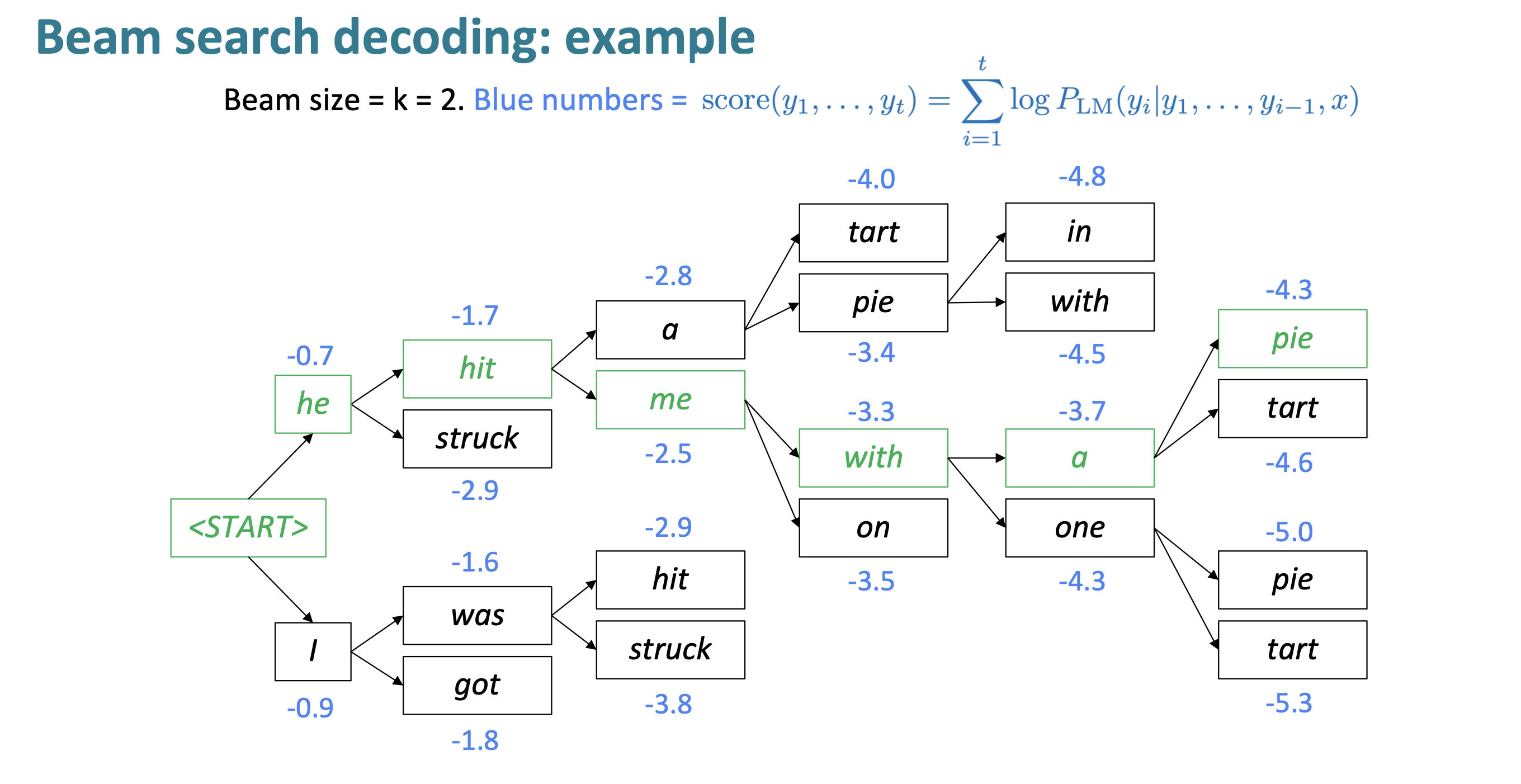
stopping criterion
- 在greedy decoding中会持续解码到$
$ token - 在beem search decoding 中,可能会提前生成$
$ token - 一个hypothesis到达$
$,则其已经完成 - 继续处理其他hypothesis
- 一个hypothesis到达$
- beem search decoding的停止条件:
- 到达预设timestep T
- 有预设的n个hypothesis已经完成
finishing up
- 结束时获得了若干个hypothesis,需要从中选择最合适的
- 如果直接使用score,则长度越长score越小
- 需要对score按长度标准化(乘$\frac{1}{T}$)
advantages and disadvantages of NMT
- advantage
- 性能更好,翻译更通顺,从上下文使用了更多信息
- 端到端系统
- 手动工作更少,不需要特征工程和对每种语言单独建模
- disadvantage
- 可解释性
- 可控性(无法制定规则)
- 安全性
attention
- 源序列encoding过程需要捕获源语句的所有信息,存在信息瓶颈
- attention的核心思想:在decoder的每一步,用encoder的连接来使其能关注到源序列的特定部分
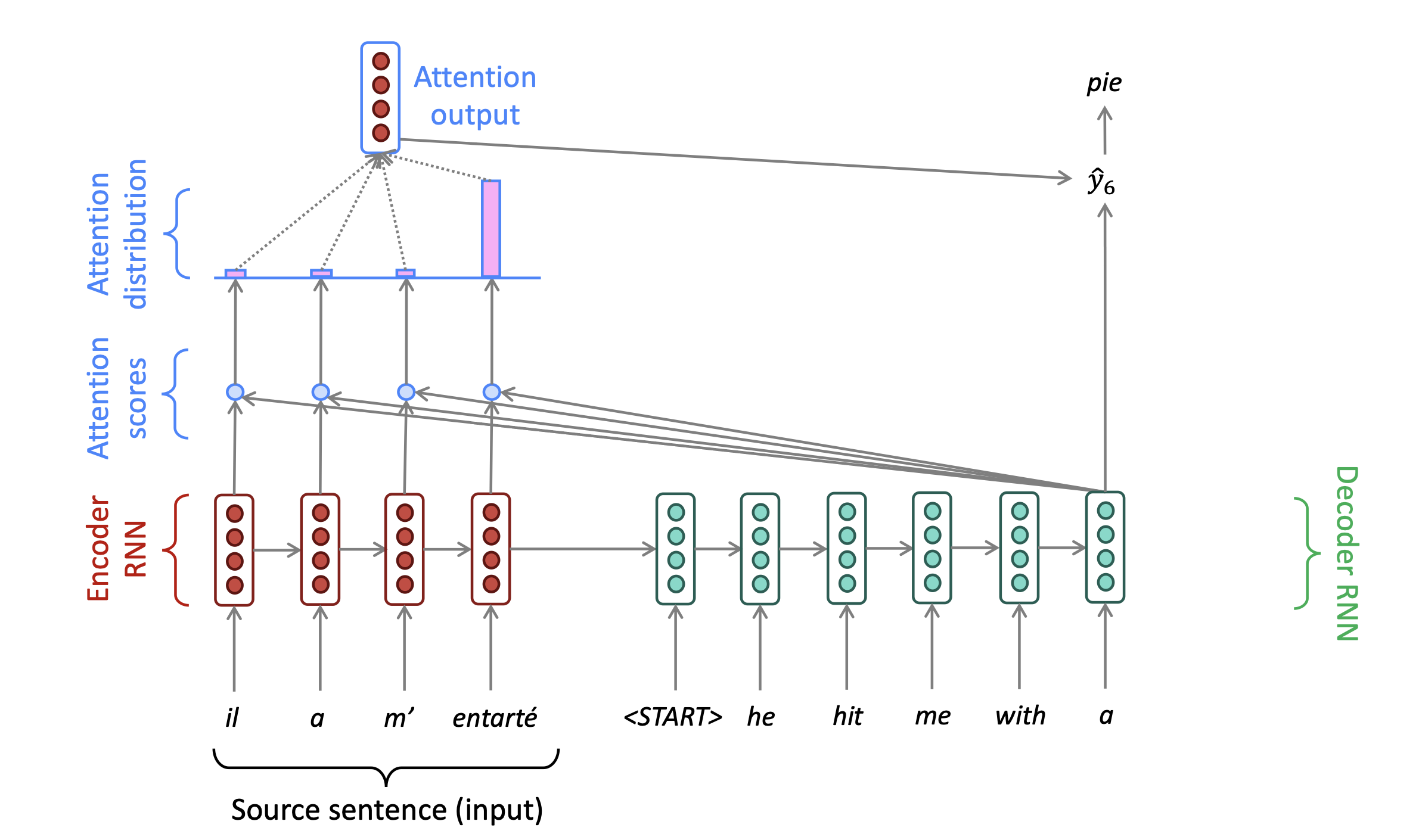
Lecture 8. self-attention and Transformer
attention in equations
- encoder hidden states: $h_i\in \mathbb{R}^h$
- decoder hidden state on timestep t: $s_t\in \mathbb{R}^h$
- attention scores: $e^t=[s^T_th_1,\dots,s_t^Th_N]\in\mathbb{R}^N$
- attention distribution: $\alpha^t={\rm softmax}(e^t)\in\mathbb{R}^N$
- attention output $\mathbf{a}_t=\Sigma_{i=1}^N\alpha_i^t\mathbf{h}_i\in\mathbb{R}^h$
- $[\mathbf{a}_t,s_t]\in\mathbb{R}^{2h}$
advantages of attention
- 绕过了信息瓶颈的问题,直接允许decoder连接来自source的信息
- 注意力机制更human-like
- 可以解决梯度消失问题——direct connection
- 可解释性
- 提供了soft alignment(网络自己学习了alignment)
- 通过注意力分布可以看到decoder的关注点
attention variants
query attends to the values
给定values $h_!,\dots,h_N\in\mathbb{R}^{d_1}$和query $s\in\mathbb{R}^{d_2}$,attention机制包括:
- 计算attention scores $e\in\mathbb{R}^N$
- 计算softmax获得attention distribution $\alpha={\rm softmax}(e)\in\mathbb{R}^N$
- 对attention distribution加权求和 $\mathbf{a}=\Sigma_{i=1}^N\alpha_i\mathbf{h}_i\in\mathbb{R}^{d_1}$
几种attention方法
- dot-product attention: $e_i=s^Th_i$
- 要求$s$和$h$维度相同
- multiplicative attention: $e_i=s^TWH_i$
- $W\in\mathbb{R}^{d_1\times d_2}$是一个额外的权重矩阵
- 权重似乎过多,需要学习对所有部分的attention
- reduced rank multiplicative attention: $e_i=s^T(U^TV)H_i=(Us)^T(Vh_i)$
- $I\in\mathbb{R}^{k\times d_2}, V\in\mathbb{R}^{k\times d_1},k\ll d_1,d_2$
- additive attention: $e_i=v^T{\rm tanh}(W_1h_i+W_2s)$
- $W_1\in\mathbb{R}^{d_3\times d_1},W_2\in\mathbb{R}^{d_3\times d_2}$是权重矩阵,$v\in\mathbb{R}^{d_3}$是权重向量
- 实际上用了一个网络来计算attention
Lecture 9. Transformers
Transformer
Issues with RNN
- Linear interaction distance:捕获两个词的交互需要$O(sequence length)$ steps
- 长程依赖问题(梯度难以传播)
- 线性顺序的输入处理sentence不合理
- Lack of parallelizability
- forward 和 backward都需要$O(sequence length)$
if not recurrence, the what?
- word window(CNN)
- 1D-Conv
- maximum interaction distance = sequence length/window size——通过多层卷积
- attention
self-attention
self-attention equation
- query $q_i\in\mathbb{R}^d$
- key $k_i\in\mathbb{R}^d$
- value $v_i\in\mathbb{R}^d$
- 对self-attention来说,q,k,v来自同一个东西
- 最简单的方式是$q_i=k_i=v_i=x_i$
- 此时$e_{ij}=q_i^Tk_j$
- $\alpha_{ij}=\frac{exp(e_{ij})}{\Sigma_{j’}exp(e_{ij’})}$
- $output=\Sigma_j{\alpha_{ij}v_j}$
Problem1. sequence order(position embedding)
- self-attention对语序完全不敏感,所以需要编码order
- 考虑将sequence index编码为vector $p_i$,加到qkv上
sinusoidal position representations
$PE_{(pos,2i)}=sin(pos/10000^{2i/d_{model}})$
$PE_{(pos,2i+1)}=cos(pos/10000^{2i/d_{model}})$
- 绝对位置并不那么重要
- 可以外推到更长的长度(周期性)
- 没有可学习的参数
learned absolute position representation
学习position embedding matrix $p \in \mathbb{R}^{d\times T}$
- 比较灵活,每个位置都可以根据data去学习
- 长度固定,无法外推
Problem2. lack of nonlinearities
- self-attention只是weighted average,不包含非线性
- 解决方案
- 添加一个feed-forward network对输出做后处理
- $m_i=MLP(o_i)=W_2ReLu(W_1o_i+b_1)+b_2$
Problem3. “don’t look at the feature”
- 在decoder中需要mask
- mask out attention to future words——将attention scores设置为$-\infty$
Transformer
key-query-value attention
- $k_i=Kx_i, K \in\mathbb{R}^{d\times d}\text{ is the key matrix}$
- $q_i=Qx_i, Q \in\mathbb{R}^{d\times d}\text{ is the query matrix}$
- $v_i=Vx_i, V \in\mathbb{R}^{d\times d}\text{ is the value matrix}$
- $output=softmax(XQK^TX^T)XV$
multi-head attention
- $Q_l,K_l,V_l\in \mathbb{R}^{d\times\frac{d}{h}}$
- 计算attention然后concat
Residual connection
- instead of $X^{(i)}=Layer(X^{(i-1)})$
- let $X^{(i)}=X^{(i-1)+Layer(X^{(i-1)})$
layer normalization
- layernorm的成功可能因为其对梯度的norm
- $x\in\mathbb{R}^d$是一个单独的word vector
- $\mu=\Sigma_{j=1}^dx_j\in \mathbb{R}$是均值
- $\sigma=\sqrt{\frac{1}{d}\Sigma_{j=1}^d(x_j-\mu)^2}\in\mathbb{R}$是标准差
- $\gamma\in\mathbb{R}^d,\beta\in\mathbb{R}^d$是可学习的gain和bias参数(工业上的习惯)
- $output=\frac{x-\mu}{\sigma+\epsilon}*\gamma+\beta$
scaled dot-product
- 向量维度很大时,dot-product也会很大,导致softmax很陡峭,梯度很小
- ${\rm Attention}(Q,K,V)={\rm softmax}(\frac{QK_T}{\sqrt{d_k}})V$
why fix about Transformer
- quadratic compute in self attention
- linear in RNN
- position representation
- relative linear position attention
- dependency syntax-based position
varient of Transformer
- for quadratic compute
- 投影到更低维度计算attention (linformer)
- 不计算所有的pairs,只计算一部分(BigBird)
for pretrain
- 如果只用decoder,则不需要cross attention和layernorm
Lecture 10. Transformers and pretrain
word structure and subword models
- 测试时遇到的OOV word将会被映射为UNK
- 有限的词汇显然不能满足很多语境
the byte-pair encoding algorithm
- 从只包含单个字母的vocabulary开始
- 寻找最常相邻出现的字母,将其添加为subword
- 不断添加直到特定的大小
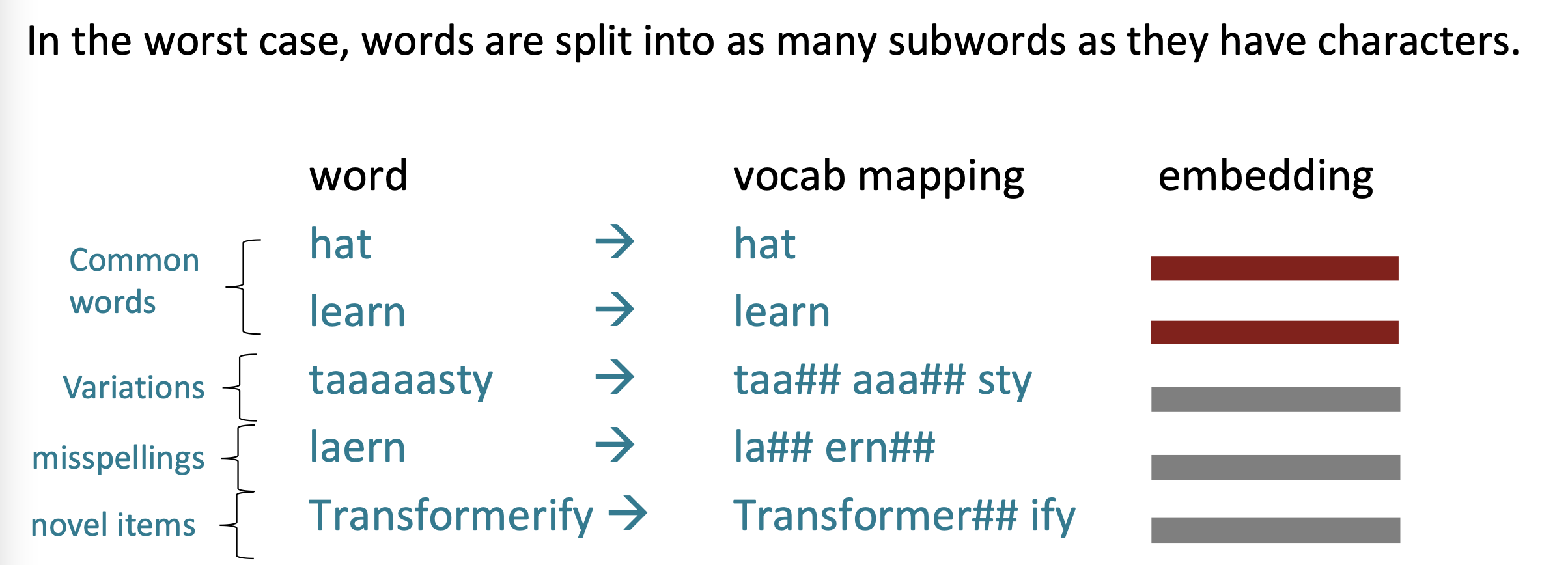
Motivating model pretraining from word embedding
two types of pretrain
pretrained word embedding
- 仅预训练词向量
- 预训练的训练数据必须能够充分学习上下文
- 一个word的预训练词向量是固定的,与上下文无关
- 整个网络的大部分仍是随机初始化的
pretraining whole models
- 所有参数都被pretrain
- 可以学习语言的概率分布
three ways of model pretrain
- decoder
- LM
- 生成任务,看不到future word
- encoder
- 有双向的context
- 如何训练??
- encoder-decoder
Decoder
- finetune可以忽略pretrained model原本的任务

可以继续用generator的方法(Prompt)

GPT
- 12层 Transformer decoder
- GPT-2
- 更大的GPT
Encoder
- encoder方法中可以看到双向的上下文,不能直接用LM方法训练
Idea:用[MASK] token盖住部分word,让模型预测被盖住的word
- 只添加masked word 的loss,称作Masked LM
BERT
- 预测15%的(sub)word
- 80% 用[mask]替换
- 10% 用随机的token替换
- 10% 不变(但仍然predict)
- bert也预测下一个chunk是真实follow的还是随机采样的,即next sentence prediction(NSP)
- 预测15%的(sub)word
limitation of pretrained encoders
- 在生成任务上最好使用decoder
- bert在自回归任务上并没有那么好
extension of bert
- RoBERTa:train BERT for longer and remove next sentence prediction
- SpanBERT:连续mask——更难且有用的任务
encoder-decoder
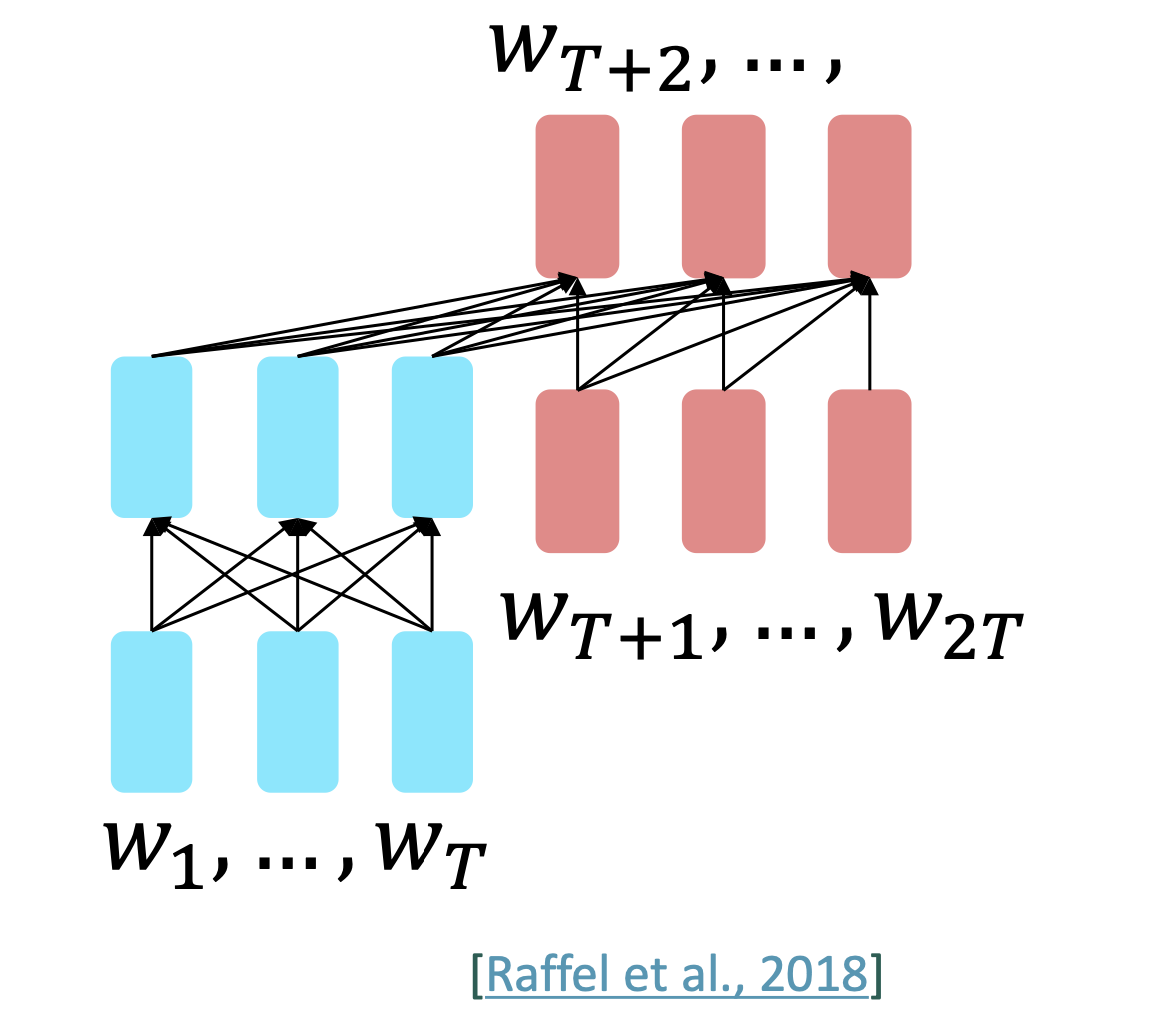
- Encoder编码prefix且不进行预测,Decoder预测后面的部分
encoder从context受益,decoder则像LM一样预测
T5
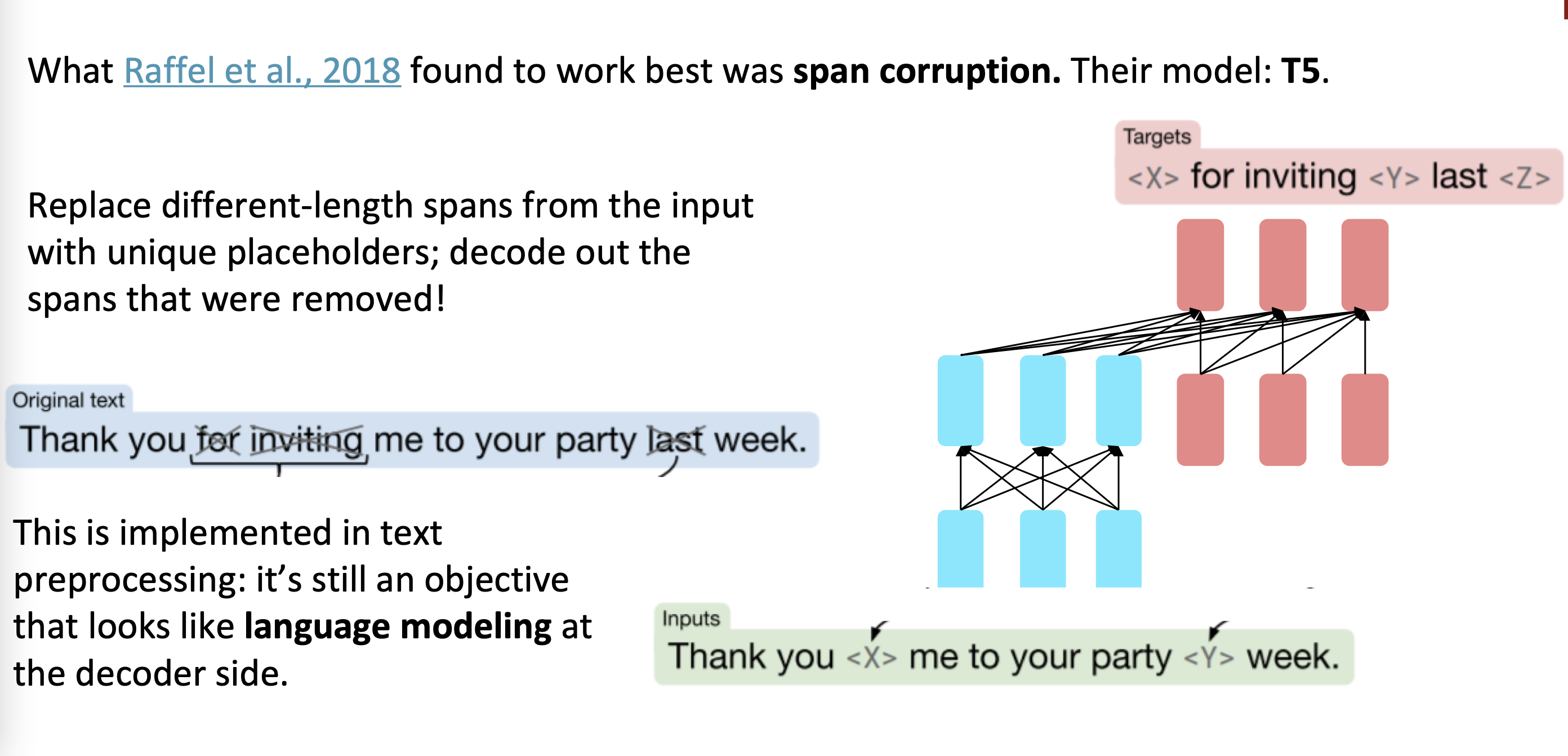
- span corruption
- 从输入中用特定的占位符去替代不同长度的文本(和BERT不同的是,T5只知道此处缺失,不知道缺失的长度)
- decoder解码出缺失部分
- span corruption
very large model and in-context learning
- 两种使用pretrained model的方式:
- prompt
- finetune
- GPT-3
- seems to perform some kind of learning withou gradient steps simply from examples you provide within their contexts
- in-context learning:甚至没有finetune
Lecture 11. QA (Chen Danqi)
QA
Read Comprehension
理解一段text,然后回答一段问题 $(Passage, Question)->Answer$
Problem formulation for SQuAD(Stanford的QA数据集,answer在passage中出现)
- Input: $C=(c_1,c_2,\dots,c_N),Q=(q_1,q_2,\dots,q_M),c_i,q_i\in V$
- Output: $1\le start \le end le N$
neural models for reading comprehension
- LSTM-based model
- BERT finetune model
LSTM-based model
- MT任务中的source和target变成passge和question
- 需要通过attention建模哪些word和question最相关,以及和question中哪部分word相关
- 不需要auto regressive decoder,而是训练预测start和end位置的分类器
BiDAF(Bidirectional Attention Flow)

- Encoding:character embed layer+word embed layer+phrase embed layer
- $e(c_i)=f([Glove(c_i);charEmb(c_i)])$
$e(q_i)=f([Glove(q_i);charEmb(q_i)])$
将word embedding(GloVe)和character embedding(CNN+maxpooling over character embedding)拼接在一起,并通过high-way networks - 用Bi-LSTM生成context和query的上下文embedding
- $e(c_i)=f([Glove(c_i);charEmb(c_i)])$
- attention:attention flow layer
- context-to-query attention:对context中的word,寻找query中与之最相关的word
- query-to-context attention
- 计算每个词对的similarity score
$S_{i,j}=w_{sim}^T[c_i;q_j;c_i\odot q_j]\in\mathbb{R}, w_{sim}\in\mathbb{R}^{6H}$
c2q: 找出和c_i相关的question words $\alpha_{i,j}=softmax_j(S_{i,j})\in\mathbb{R}, a_i=\Sigma_j\alpha_{i,j}q_j\in\mathbb{R}^{2H}$
q2c: 找出context中重要的词 $\beta_i=softmax_i(max_j(S_{i,j}))\in\mathbb{R}^{N}, b_i=\Sigma_i\beta_ic_i\in\mathbb{R}^{2H}$
output: $g_i=[c_i;a_i;c_i\odot a_i;ci\odot b_i]\in\mathbb{R}^{8H}$
- modeling and output layer
- modeling layer: 将$g_i$送进两层Bi-LSTM
$m_i=BiLSTM(G_i)\in\mathbb{R}^{2H}$- attention layer用于建模query和context的关系
- modeling layer用于建模 context内部的关系
- output layer: 两个用于预测start和end位置的classifer
$p_{start}=softmax(w_s^T[g_i;m_i])$
$p_{end}=softmax(w_e^T[g_i;m_i’]), m_i’=BiLSTM(m_i)\in\mathbb{R}^{2H}$
- modeling layer: 将$g_i$送进两层Bi-LSTM
Bert for reading comprehension
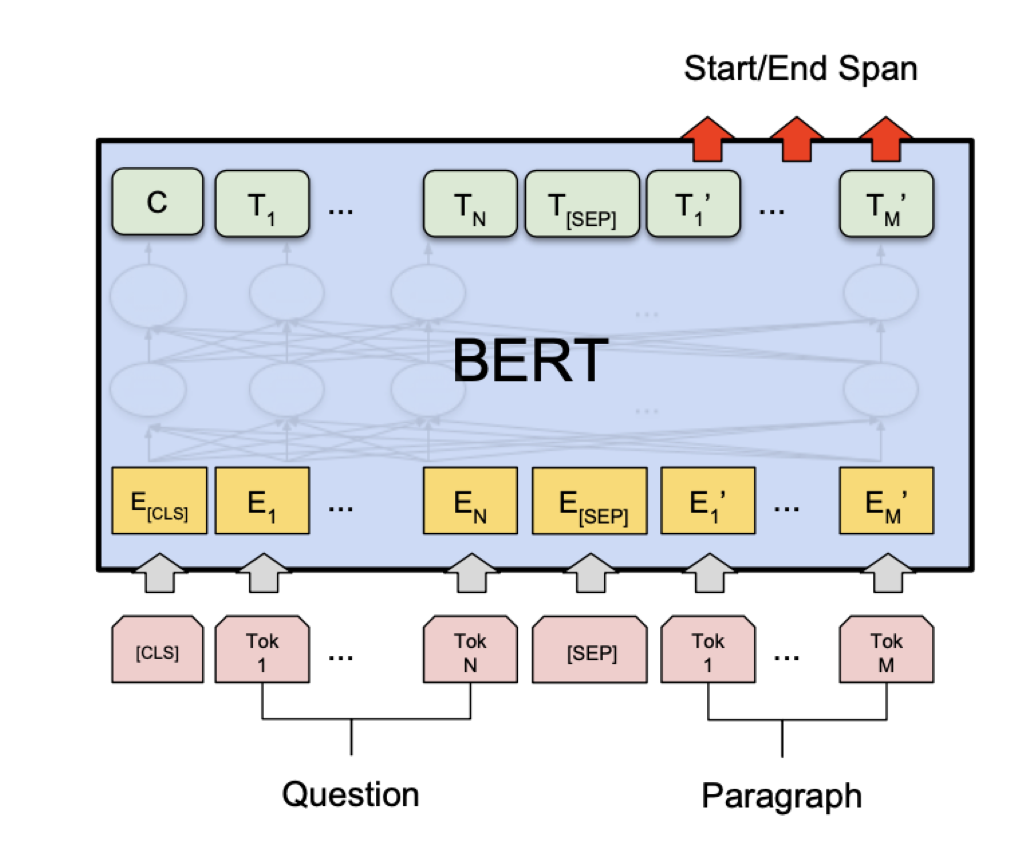
comparisons
- BiDAF等模型捕获question和passage的关系
- BERT在question和passage的concat上做self-attention(attention(p,q),attention(q,p),attention(p,p),attention(q,q)),包含了q和p的关系
- Clark and Gardner, 2018证明在BiDAF中添加attention(p,p)可以获得提升
Lecture 12.natural language generation(Antoine Bosselut)
natural language generation(Antoine Bosselut)
what is NLG
- NLG task
- Machine Translation
- dialogue systems
- Summarization
- Data-to-Text Generation
- visual description
- creative generation
formulating for NLG
- auto-regressive model
- Step: $S=f({y_{<t},\theta})$
$P(y_t|{y_{<t}})=\frac{exp(S_w)}{\Sigma_{w’\in V}exp(S_{w’})}$ - Loss: $L=-\Sigma_t logP(y_t|{y_{<t}})$
decoding from NLG models
Greedy methods
- argmax decoding
- beam search
get random: sampling
top-k
- 每次只选top k个token
- 增大k会让模型更多样也容易出错
- 减小k会让模型更greedy
top-p
- top-k的问题
- 对平滑的分布,top-k会削减许多可能的选项
- 对陡峭的分布,top-k会添加许多不太可能的选项
- solution
- 根据分布的特点,动态选取k
- 调整(rebalance)概率分布:除以一个超参数 $\tau$后再计算softmax
re-balancing distribution
仅依赖model输出的概率分布可能并不可靠
- 根据n-gram的统计数据来调整概率分布
- 根据梯度反向传播调整概率分布
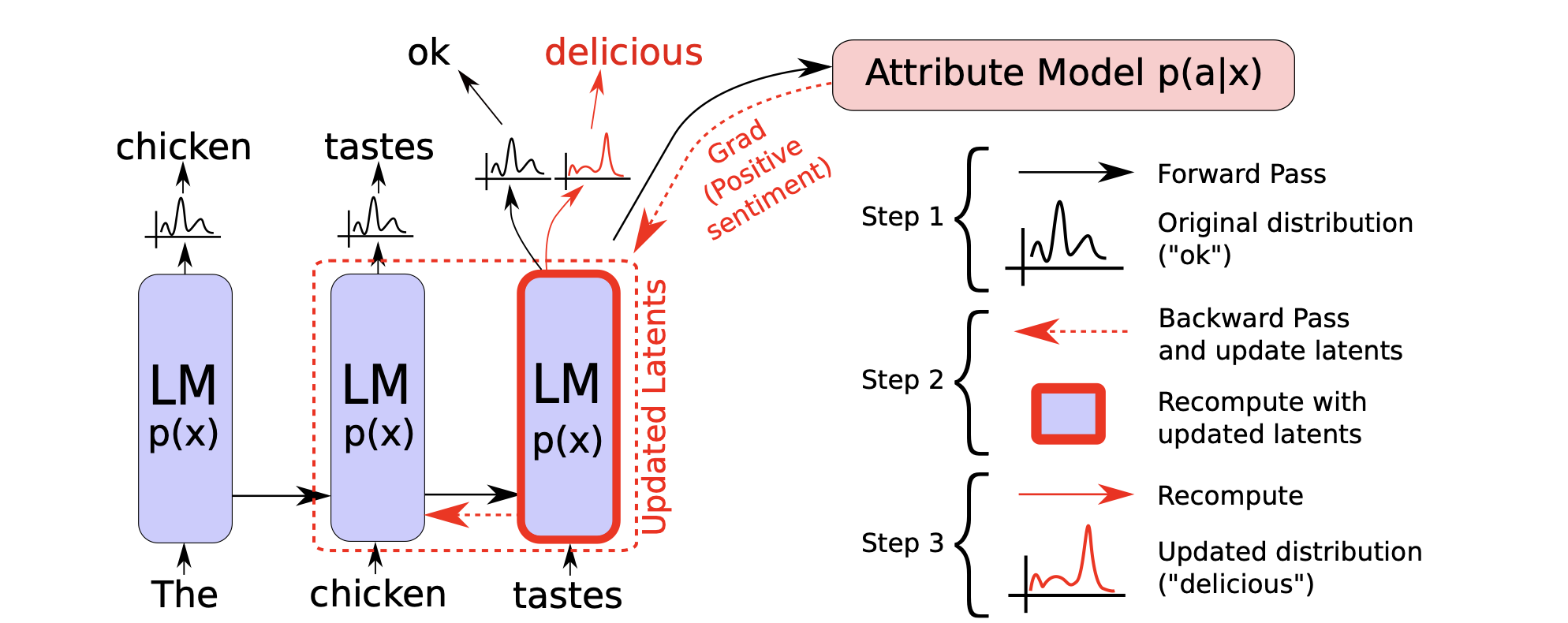
traning NLG models
Maximum Likelihood Training
$L=-\Sigma_t logP(y_t|{y_{<t}})$
不利于多样化的text generation
Unlikelihood Training
给定一个不期望得到的token 集合$\mathcal{C}$,降低其在上下文中的likelihood
$\mathcal{L}_{UL}^t=-\Sigma_{y_{neg}\in\mathcal{C}}log(1-P(y_{neg}|\{y\}_{<t}))$
将unlikelihood和likelihood结合
$\mathcal{L}_{ULE}=\mathcal{L}_{MLE}+\alpha\mathcal{L}_{UL}$
exposure bias问题
- 训练时,模型输入的是gold context;生成时,模型输入是decoder之前的输出
- Solution
- scheduled sampling
- 以概率p解码出一个token并送入模型作为下一个input(而非gold token)
- 在训练过程中逐渐增大p
- 但训练中同时也会生成一些奇怪的输出
- scheduled sampling
- dataset aggregation
- 在训练过程中,生成一些新序列加入训练集
- sequence re-writing
- 在corpus中搜索一个human-written的prototype text,
- reinforcement learning
evaluating NLG
- N-gram overlap metrics——BLEU、ROUGE、METEOR(效果不好)
- semantic overlap metrics——PYRAMID、SPICE、SPIDEr
- model-based metrics
- word distance functions
- vector similarity
- word mover’s distance
- bert score
- beyond word matching
- sentnce movers similarity
- BLEURT
- word distance functions
- human evalutions
Lecture 13. Coreference resolution
Co-reference resolution
what is co-reference resolution
识别出文本中共指同一个实体的单词
application
- 文本理解
- 信息抽取、QA、summarization
- 机器翻译
- 对话系统
- 文本理解
co-reference resolution in two steps
- detect the mentions——easy
- cluster the mentions——hard
mention detection
- detect a span of text referring to some entity
- pronouns: I, your, it, she, him, etc.
- named entitied: people, place, Biden, etc.
- noun phrase: a dog, etc.
- 简单但没那么简单
- 很多结果并非mentions
- it is sunny、every student
how to deal with bad mentions
- 可以训练一个分类器来过滤掉spurious mentions
- POS tagger、NER、parser
- 更常用的方法:让所有的mentions都作为”candidate mentions”
- 在co-reference 系统运行完后,丢弃掉这些mention
some linguistics
- co-reference:两个mention指代同一个实体
anaphora:一个照应词anaphor指代另一个先行词antecedent
并非所有的anaphoric关系都是co-referential
- 并非所有的词都有reference
- every dancer twisted her knee
二者都有 - no dancer twisted her knee
存在anaphoric但没有co-referential
- every dancer twisted her knee
- bridging anaphora
- We went to see a concert last night. The tickets were really expensive.
- tickets对concert没有co-reference,是bridging anaphora的关系
- 并非所有的词都有reference
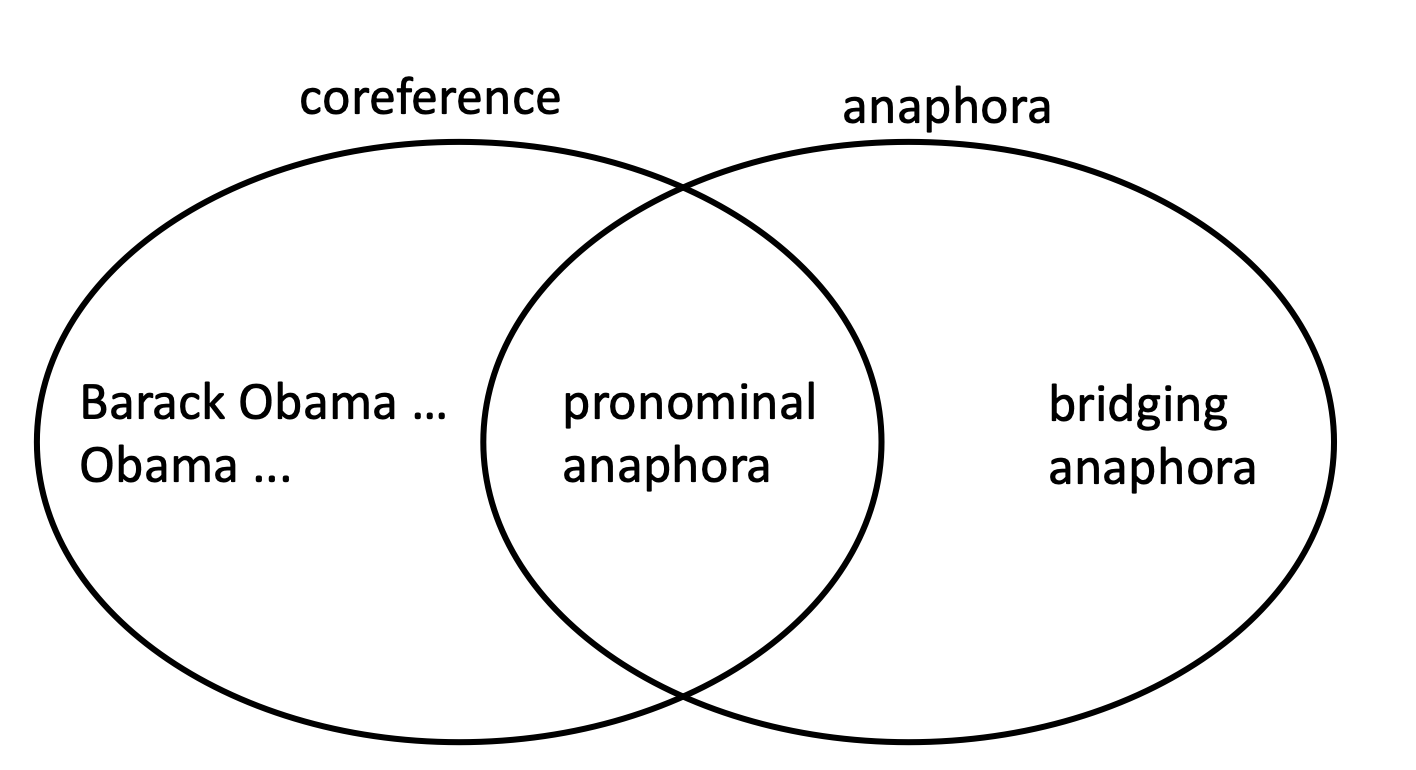
4 kinds of co-reference models
- Rule-based(pronominal anaphora resolution)
- mention pair
- mention ranking
- clustering
Hobbs’ naive algo
- Rule-based
并未真正理解语言
Knowledge-based Pronominal Coreference
- She poured water from the pitcher into the cup until it was full.
- She poured water from the pitcher into the cup until it was empty.
- The city council refused the women a permit because they feared violence.
- The city council refused the women a permit because they advocated violence
mention pair
- 训练一个二分类器,对每个mention pair分类
- Loss:regular CE loss
- $J=-\Sigma^N_{i=2}\Sigma^i_{j=1}y_{ij}log\ p(m_j,m_i)$
选择一定的阈值,置信度大于该阈值即添加co-reference 连接
disadvantage
- 许多mention只有一个co-reference 连接
- solution
- 对每个mention只计算一个antecedent
mention ranking
- 为得分/概率最高的candidate添加连接
- Loss:
- $J=\Sigma^{i-1}_{j=1}\mathbb{1}(y_{ij}=1) p(m_j,m_i)$$
how to calculate score/probability
- Non-neural statistical classifier
- Simple neural network
- More advanced model using LSTMs, attention, transformers
Non-Neural model: Features
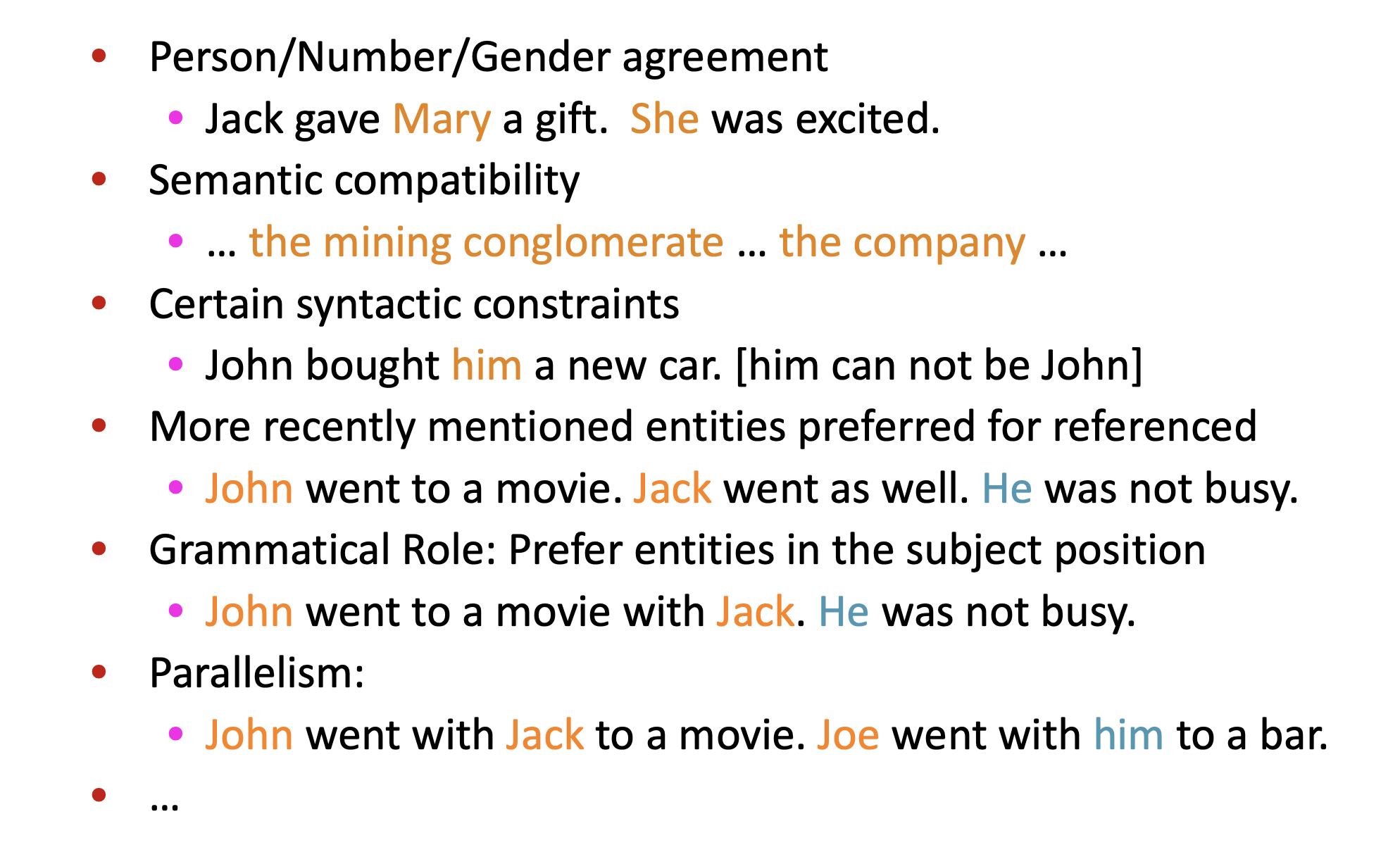
neural model:标准前馈神经网络
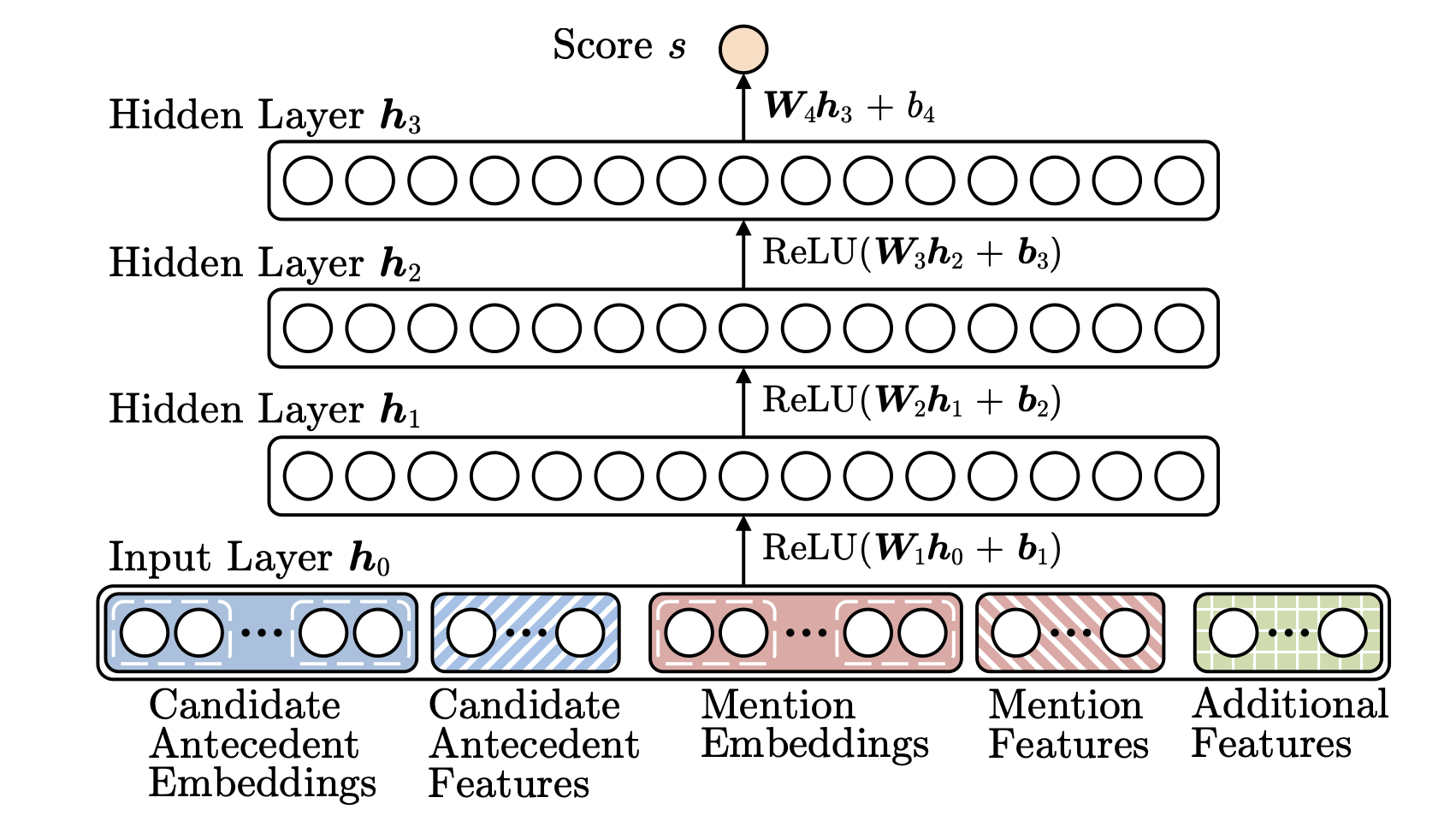
- 输入word embedding和distance、document genre体裁、speaker infomation等其他特征
neural model:CNN
- 忽略了语法信息,并不那么linguistically
neural model:end-to-end neural coref model
- mention ranking model
- 在FFN基础上使用LSTM、attention
- 没有mention detection的过程
- 不再将每段文本都作为candidate,利用attention去修剪
模型架构:
- 用character-level CNN embed the words
- 将document送入Bi-LSTM
- 将每个span表示为向量
- 计算每对span的得分

$\hat x_i$是span中word embedding的attention加权求和。
- $score(i,j)=s_m(i)+s_m(j)+s_a(i,j)$
- $s_m(i)=w_m\cdot FFNN_m(g_i)$ 表征i是否为mention
- $s_a(i,j)=w_a\cdot FFNN_a([g_i,g_j,g_i\circ g_i,\phi(i,j)])$表征i和j是否coreferent
neural model:BERT-based model
- idea
- 预训练在span-based预测任务上(coref和QA)表现更好的BERT模型
- BERT-QA:将coref看作QA task
- Q:mention
- A:mention的antecedent
co-reference evaluation
- B-cubed
- 对每个mention计算p和r
- 对P和R取平均
Lecture14. T5 and large LM:the good, the bad and the ugly(Colin Raffel)
T5 and large LM
larger LM
- larger corpus
- more parameters
- more tokens
- different optimizer
T5(Text-to-text Transfer Transformer)
- text-to-text task
- MT
- CoLA(Corpus of Linguistic Acceptability)
- STS-B(Semantic Textual Similarity Benchmark)
- summarize
- pre-train dataset
- C4 dataset
objective
- original text
- thank you for inviting me to your party last week
- inputs
- thank you
me to your party week
- thank you
- targets
for inviting last
pretrain
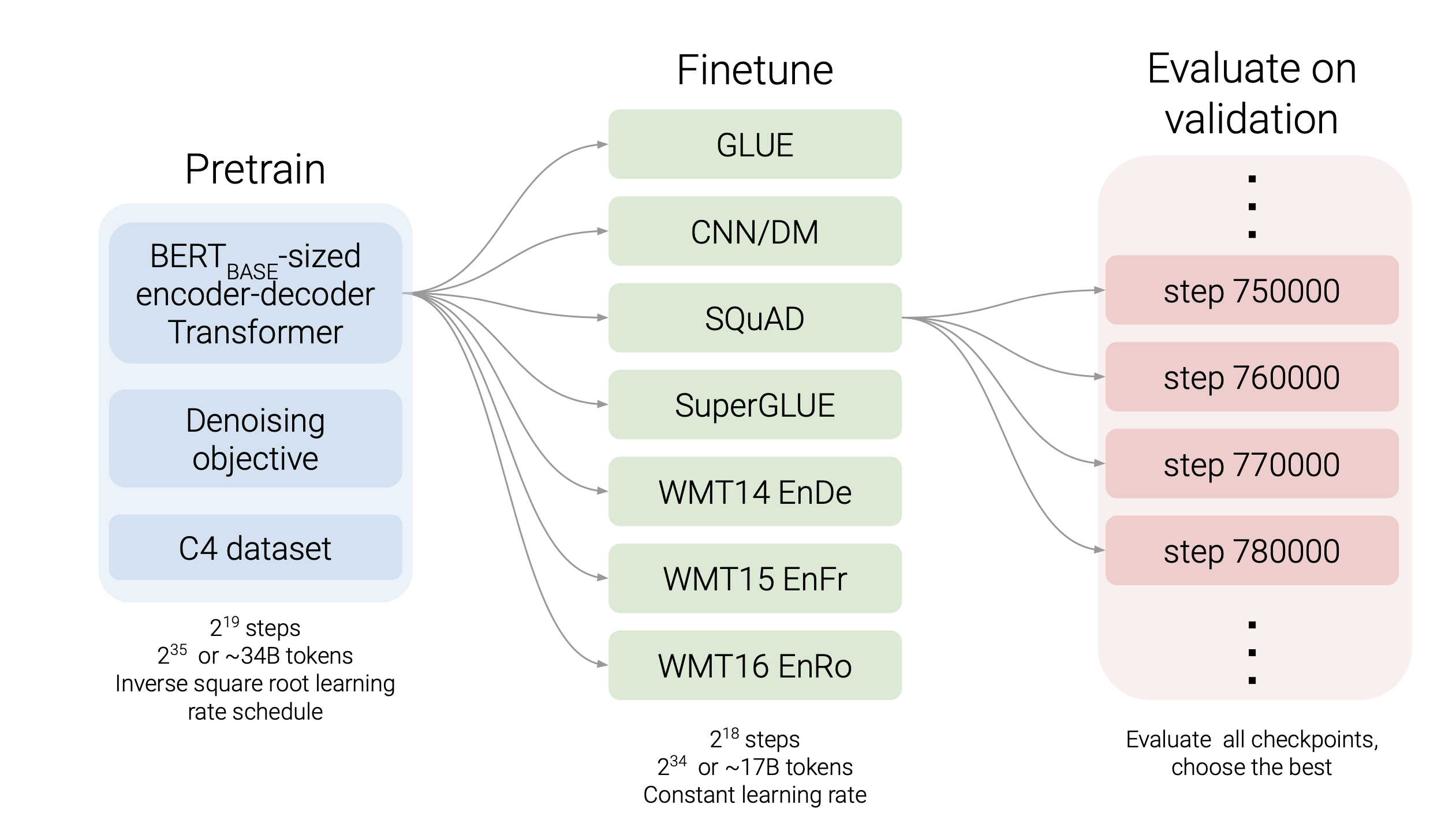
Lecture 14. Integrating knowledge in language models
Integrating knowledge in language models
can a LM be used as a KB?
what does a LM know?
- 预测结果通常是有意义的(语法/类型匹配),但并不正确
- 原因:
- unseen fact:在训练集中一些fact还没有发生
- rare fact:样本不够,无法记住相关fact
- model sensitivity:对上下文非常敏感
- x was made in y 和 x was created in y
advantages of LM over traditional KB
- LM从大规模非结构化和无标注文本上预训练
- KB需要人工标注和复杂的NLP规则
LM支持更灵活的query
challenges
- 难以解释某些结果
- 有时难以相信
- 难以修改模型
techniques to add knowledge to LMs
- add pretrained entity embeddings
- ERNIE
- KnowBERT
- use an external memory
- KGLM
- KNN-LM
- modify the training data
- WKLM
- ERNIE, salient span masking
add pretrained entity embedding
- 真实世界的事物通常是实体
- pretrained word embedding没有实体的概念
- 比如USA和America是指向同一实体的
- 解决方案
- 对指向同一实体的words连接同样的entity embedding
entity linking:link mentions in text to entities in a KB
- 对指向同一实体的words连接同样的entity embedding
techniques for training entity embeddings
- KG embedding(TransE)
- word-entity co-occurrence(Wikipedia2Vec)
- Transformer encodings of entity description(BLINK)
how to incorporate entity embeddings from a different embedding space
- 学习一个fusion layer融合context和entity information
$h_j=F(W_tw_j+W_Ee_k+b)$
ERNIE
architecture
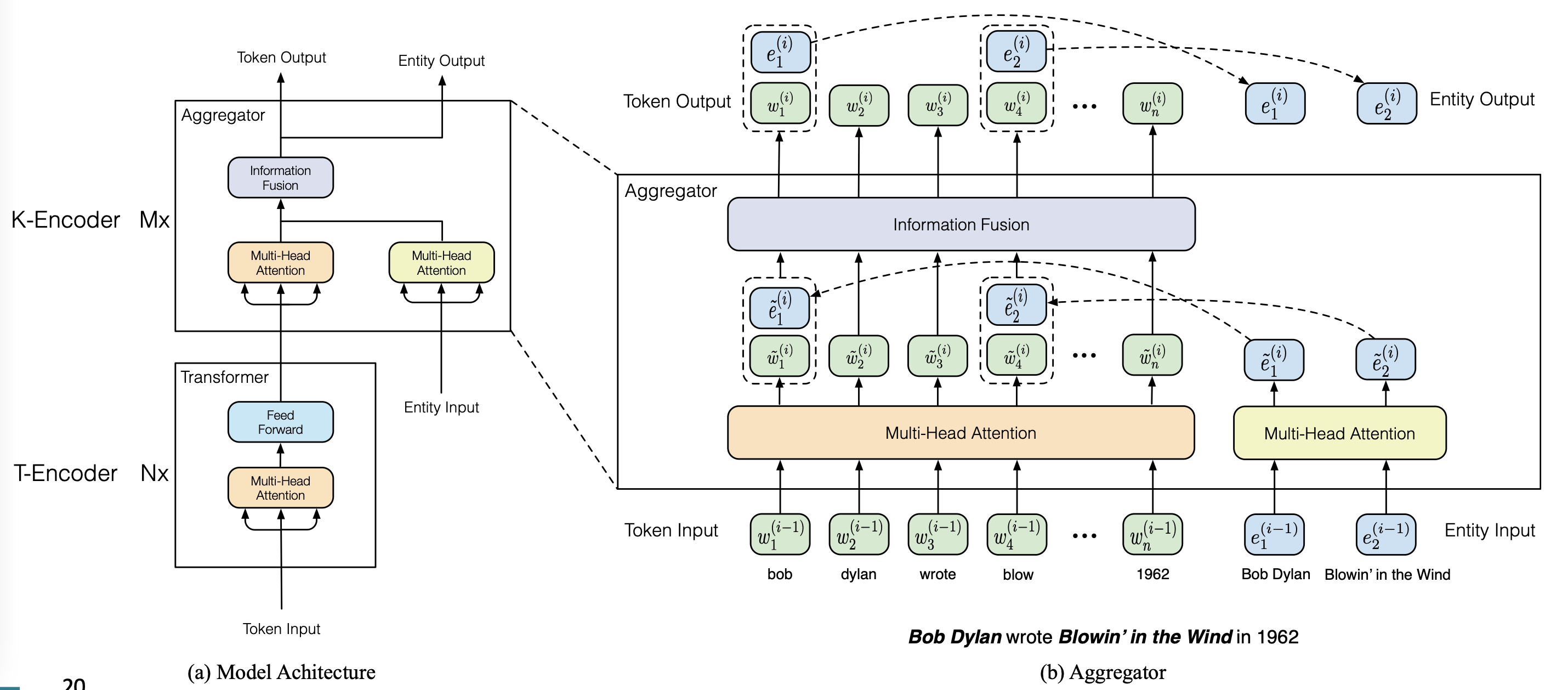
- text-encoder
- multi-layer bidirectional Transformer
- knowledge encoder
- 2 multi-head attention over entity embedding and token embedding
- 1 fusion layer to combine
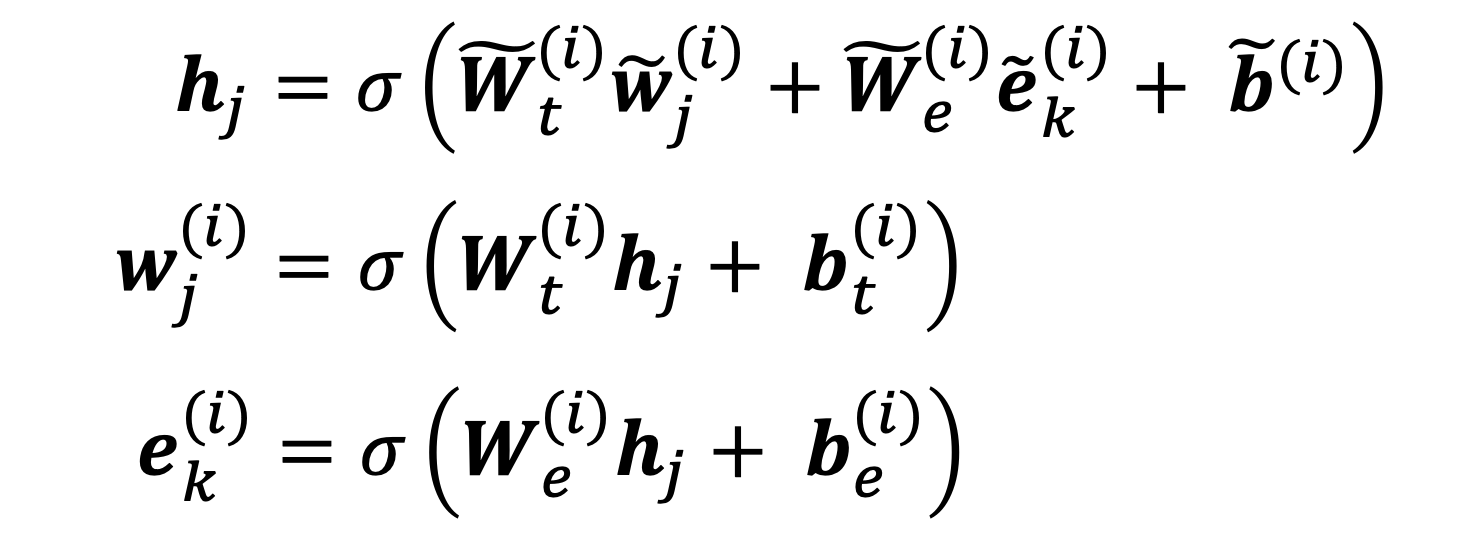
pretrain tasks
- BERT tasks
- MLM
- NSP
- knowledge pretraining task(dEA, denoising entity autoencoder)
- 随机mask掉一个token-entity alignment,然后根据sequence中的实体预测出该token的相关entity
$p(e_j|w_i)=\frac{exp(Ww_i\cdot e_j)}{\Sigma_{k=1}^{m}exp(Ww_i\cdot e_k)}$
- 随机mask掉一个token-entity alignment,然后根据sequence中的实体预测出该token的相关entity
$L_{ERNIE}=L_{MLM}+L_{NSP}+L_{dEA}$
strengths
- 通过fusion layer和dEA融合了entity和context
对知识驱动的下游任务提升很大
remaining challenges
- 需要带entity标注的数据作为输入,需要一个entity linker
- 需要further pretrain
KnowBERT
- 核心思想:在BERT之外预训练一个entity linker
$L_{KnowBERT}=L_{MLM}+L_{NSP}+L_{EL}$ - 在下游任务中,不需要额外的entity标注
KGLM
- 之前的方法依赖于预训练的entity embedding来从KB编码知识
- 需要更直接的方法来为LM提供额外知识
solution:让模型可以直接访问三元组(key-value store)
advantages
- 可以更好地更新知识
- 可解释性更强
核心思想:在KG上调整LM
- 利用entity的信息来预测下一word $P(x^{(t+1)},\epsilon^{(t+1)}|x^{(t)},\dots,x^{(1)},\epsilon^{(t)},\dots,\epsilon^{(1)})$
$\epsilon^{(t)}$是t时刻提及的KG entities
architecture
- 在迭代时构建一个”local” KG
- local KG——full KG的子集:只包含和sequence相关的entities
- next word有三类:
- 已经在local KG中的related entity
- 需要找到最高得分的head和relation
- $P(e_h)=softmax(v_h\cdot h_t)$
- 找到tail entity
- 从entity扩展token
- 不在local KG中的new entity
- 在full KG中找到tail entity
- 非entity
- 退化
- 已经在local KG中的related entity
- 用LSTM的hidden state预测net word 的类型
KNN-LM
- 核心思想:学习句子间的similarity要比预测next word更容易,尤其对long-tail pattern更有效
- 寻找k个相似句子
- 从中检索相应的value(i.e. next word)
- 将knn概率和LM概率结合
WKLM
- 之前的方法是从外部引入知识或使用额外的memory
将knowledge引入非结构文本
核心思想:训练模型去辨别知识的真伪
- 用同类型的其他entity替换,生成negative knowledge statement
- Loss:$L=L_{MLM}+L_{entRep}$,前者是token-level的,后者是entity-level的

Learn inductive biases through masking
ERNIE

- 使用更有效的mask
- phrase-level
- entity-level
Salient span masking
- mask掉salient spans
- named entities
- dates